#all other relations major and minor characters alike
Text
September MC & OCs of the Month - Special Edition: Sydney Valentine
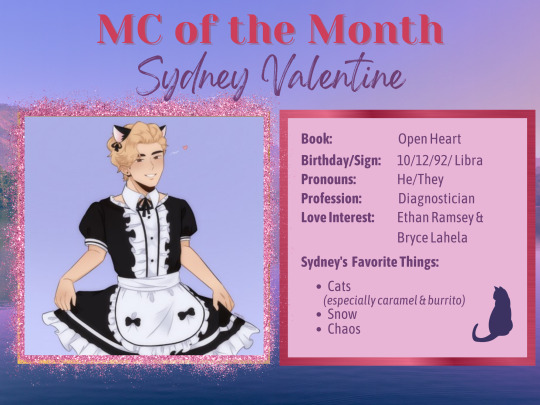
Help us in welcoming September's MCs and OCs of the month! That's right, plural! Most months, CFWC highlights one randomly selected MC or OC from our Meet My MC / OC List. (More info here.) But this month, we're doing something different.
In August, @lilyoffandoms hosted a Writers Appreciation Month, and we announced the September Writer of the Month would be selected from its participants. But all participants agreed - Lily deserved the honor! Still, we wanted to do something nice for the eleven writers who elected to participate to help uplift other writers in the fandom. So, this month, each of the eleven participants will have one of their MCs or OCs highlighted.
We will introduce each MC / OC individually, and once all eleven have been highlighted, a masterlist for the month will be created. We hope you enjoy getting to know all about them!
The fourth MC of the Month is @peonyblossom's Sydney Valentine!
Learn more about Sydney below!
MC chosen: Dr. Sydney Valentine
In your own words, tell us what you like most about your MC. I genuinely cannot decide what I like most about Sydney LMAO. I just. love him. idk.
Do you feel your MC is like you at all? How are you alike or different? I would say we’re more different than alike. Sydney loves winter/winter and snow related activities, and I just cannot handle the cold and the snow like that. He’s also more outspoken than I am. I can be outspoken when I need to be, but I like keeping to myself much more than Sydney does. Probably ’cause he’s a big extrovert, and I’m a huuuuuge introvert lol. As for things we have in common, we both like to fuck around with gender and gender expression, which is pretty cool.
What is most important to your MC? What is their motivation in life? The most important thing to Sydney/their motivation in life is making the world (or as much of it as he can, anyway) a better and safer place for minorities, especially LGBTQIA+ people and Asian Americans, because he falls into both of those groups. As a bisexual, Korean demiboy, Sydney has dealt with some major bullshit throughout his life, and his spite motivates him.
If your MC could change one thing - anything - what would it be? The American healthcare system
What is your MC’s favorite quote or song? Pretty Savage by BLACKPINK
Is there anything else you’d like to share about your MC? Sydney was one of the first, if not the first (I don’t really remember 😬) MC I shared in this fandom, and I love him with all my heart. I was a little nervous to be posting Ethan x m!MC because of the sheer amount of (very lovely) f!MCs in the OH fandom were a bit intimidating. I’m really glad I wrote for Sydney, though, because he is seriously such a fun character, and I love being able to contribute to the amount of Ethan x m!MC fics out there.
Dr. Sydney Valentine
#choices fic writers creations#cfwc mc of the month#sydney valentine#peonyblossom#playchoices#open heart
20 notes
·
View notes
Note
Hey, I am asking you because I think as an artist you can answer this better.. So I have seen people saying yuuji , wasuke, jin and sukuna look the same. But isn't it just artsyle of gege except for their hair.. Because I have seen most manga characters look the same face wise except minor differences. For example, these people were calling hazenoki the guy who fought kenjaku before takaba and kashimo similar to gojo... By their logic they should be related too.
hey anon! Thanks for stopping by, I’ll try my best to answer your ask.
yuuji, jin and wasuke don’t look the same but they definitely look similar in some ways due to them being related. sukuna also share some similarities with them and yes, the hair seems the most obvious and common charectaristic that ppl tend to notice first but then inumaki had the same hairstyle in volume 0 and he looks nothing like yuuji, sukuna, jin and wasuke. in case of hazenoki, kashimo and gojo, there are some similiraties in their design but to be honest hazenoki’s face reminds me of that one guy from demon slayer who I don’t even know the name of lol and kashimo KINDAAAA reminds me of pre unsealed gojo (he has such a baby face imo), which is probably why gege modified gojo’s design later on and gave him more sharper features. the thing is that when you want to have characters who are closely related to each other to share some similarities you would focus on their facial features the most. I would say that what makes yuuji, jin and wasuke look so similar to one another other are their eyes.
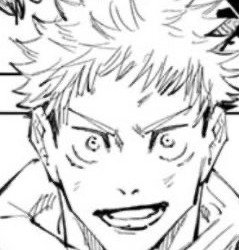
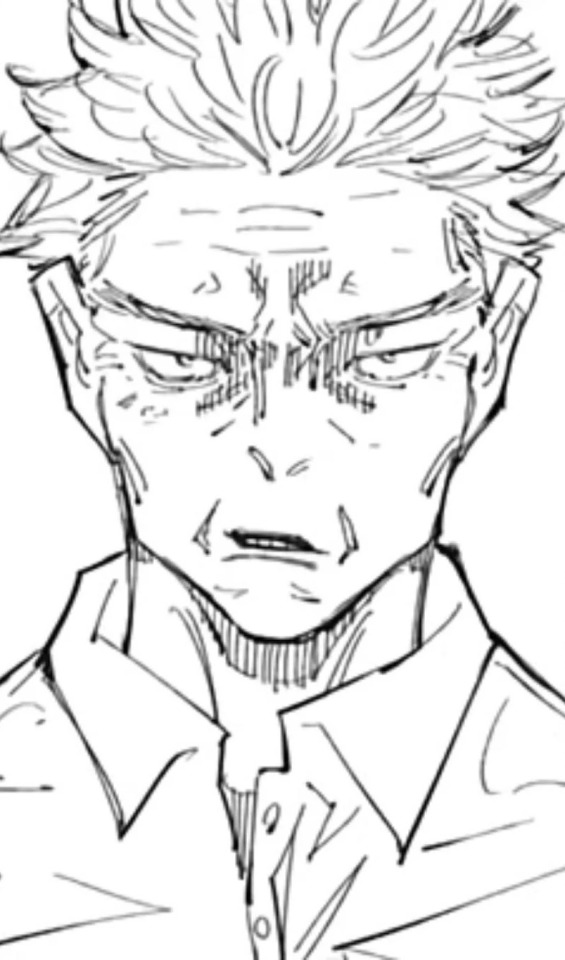

yuuji could change the colour and length of his hair and he would still probably look similar to his grandpa and father. In sukuna’s case I would say that he shares the most characteristics with wasuke.. but the thing is that the facial features don’t have to look exactly the same. the trick is to get their likeness right to have the viewer associate these characters with each other. hazenoki, kashimo and gojo don’t really have that cause they all have at least one distinctive facial feature that separates them from the other two. like hazenoki and his thick eyebrows, kashimo and his sharper eyes (similar to yuuji actually and YET they look nothing alike cause the don’t have a likeness to each other the way yuuji, jin and wasuke do) and gojo’s white eyelashes.

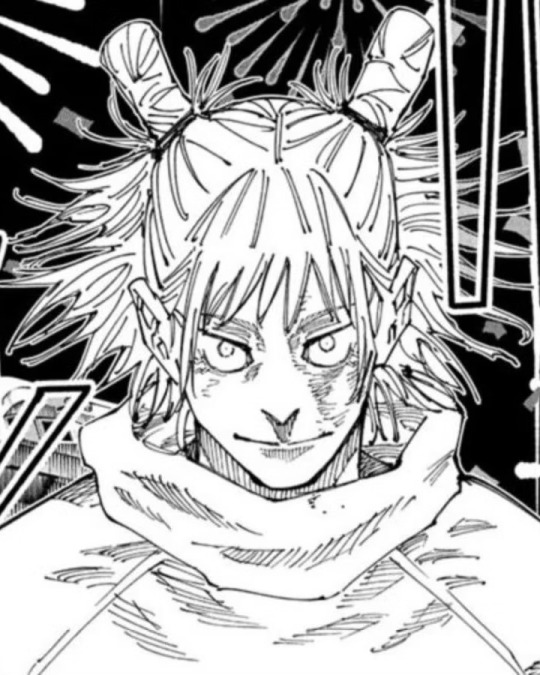

so when you want family members to look related BUT NOT THE SAME (unless their indentical twins) you would focus on their facial features the most (hair colour and hairstyle can help but that’s not what determines their likenesses), but then again it's really not about drawing the exact same features in the exact same way but drawing them in a way that makes them look very alike. I think you can think about it like when you draw a pair of eyes on a small piece of paper and then you stick it to different surfaces that have similar shapes like a balloon and a ball
and then there characters who have similar designs but don't look like they're related to one another cause of this one or two very distinctive facial feature that separates them from the other.
the thing is that, gege is not only a writer but he's also an artist and I feel like the majority of the fandom mostly associates that with his art style alone. art is so much more than just art style tho. it's also what the artist wants to convey through their work. as an artist myself, I believe that he's very much INTENTIONAL about the way he draws and portray his characters. he wants his readers to make certain connections just by the way he designs them (or makes them act or draws their facial expressions). for example the majority of the fandom knew that there must be some relation between sukuna and yuuji's family, not only because of kenjaku but also because they look like they could be related. and this was deliberate on gege’s part.
6 notes
·
View notes
Text
“Guide to the classics: The Histories, by Herodotus
Published: May 22, 2016 9.07pm BST

William Etty’s Candaules, King of Lydia, Shews his Wife by Stealth to Gyges, One of his Ministers, as She Goes to Bed. The painting illustrates Herodotus’s version of the tale of Gyges. Wikimedia Commons
It is easy to see why Herodotus’ Histories may seem overwhelming. Too much is going on, right from the start. We have only just embarked on the Histories’ central theme – the origins of the conflict between Greeks and barbarians in the fifth century BCE – when the narrative suddenly changes tack and we find ourselves in a boudoir tale of nudity, intrigue and murder, only to veer off again when a dolphin saves the singer Arion from drowning. A wild ride!
Herodotus, a Greek from the city of Halicarnassus in Asia Minor (today’s Bodrum in Turkey), published his Histories sometime between 426 and 415 BCE. His principal aim was to explain the unlikely Greek victory against the much stronger Persian army in the so-called Persian Wars that ravaged the Greek world between 500 and 449 BCE.

Statue of Herodotus. Wikimedia Commons
For his pioneering critical enquiry into the past he was named “father of history” by Cicero. His love of stories and storytelling, however, was notorious already in antiquity: Plutarch called him the “father of lies”.
Most of the tales have no clear link to the main story. They seem peripheral, if not entirely unrelated, to the account of the Persian Wars and their pre-history. Many characters appear only once, never to be seen again. To the reader accustomed to a stable cast of characters and a straightforward plot with a clear beginning, middle and end, Herodotus’ Histories read like a digression from a digression from a digression.
Yet as soon as one pauses and appreciates the stories for what they are one cannot but marvel at the events Herodotus relates. There is the conversation between King Croesus of Lydia and the Athenian statesman, reformer and poet Solon, on the true nature of human happiness. The moral is, in a nutshell: call no man happy until he is dead.
That same king consults the Delphic oracle and learns to his delight that he will bring down a great empire. Certain of victory, he wages war against the Persians; as the oracle foretells, Croesus duly ends up destroying an empire – his own.
Herodotus’ ingenuity emerges most clearly when considered in relation to Homer, who had set the benchmark and provided all writers to follow with a model for talking about the past.
Consider for example his opening statement in the beginning of the book:
Herodotus of Halicarnassus here displays his inquiry, so that human achievements may not become forgotten in time, and great and marvellous deeds – some displayed by Greeks, some by barbarians – may not be without their glory.
Unlike Homer, Herodotus no longer claims to be inspired by the Muses. Yet his opening lines still pay homage to the world of the Homeric hero and his perpetual striving for kleos (“glory”). After all, Homer, too, reported great deeds by Greeks and non-Greeks alike and preserved them for posterity.
Herodotus combined the two major themes of Homeric epic – travel and warfare – into a single whole. Travel and the insights they yield are as dominant a theme in the ethnographic sections of the Histories as expansion, warfare and conflict are in the historical sections. Herodotus uses the gradual expansion of the Persian Empire to delve deeply into the cultures of those who came under its influence in the century preceding the war. In his account the historical and the cultural influence each other.
While Herodotus does not dismiss the Iliad and the Odyssey, he openly takes a swipe at Homer at least once. Helen, he claims, never made it to Troy: she was diverted to Egypt due to bad weather. Homer – so runs Herodotus’ accusation – simply changed the course of the story to make it fit the genre of epic poetry. This shows an awareness of the particular demands of the kind of account Herodotus hoped to write as being different from Homeric epic.
The father of history
What specifically sets Herodotus and his enquiry apart, then, is the proto-scientific way he explores the inner workings of the world. The question “why” drives this inquiry in all its aspects. It brings together the different strands of Herodotean investigation: Why did the Greeks and the barbarians go to war with each other? Why does the Nile flood? Why do the women of Cyrene abstain from eating beef?
Herodotus frequently finds the answer to these questions by looking at origins and beginnings. He takes the military conflict between Greeks and barbarians back to its roots in mythical times. In a similar vein he enquires into the source of the river Nile and traces the names of the twelve Olympians – the major deities of the Greek pantheon – back to their origins in ancient Egypt.
The quest for origins and beginnings runs deep in the Histories. It introduces a form of explanation which links the disparate strands of Herodotean enquiry by presenting them as part of an ordered cosmos. The world Herodotus outlines in the Histories ultimately and profoundly makes sense.

His efforts to establish himself as a credible researcher and narrator are tangible throughout. He is careful to tell his reader from where he derived his information on foreign lands, whether he witnessed personally or learnt from a reliable source:
As far as Elephantine I speak as an eye-witness, but further south from hearsay.
My own observation bears out the statement made to me by the priests…
Of the Pelasgian language I cannot speak with certainty…
Frequently, he gives us all the different explanations sourced from others. In the case of the flooding of the Nile he adds why he favours one (incidentally, the wrong one) over all others. By presenting views other than his own, Herodotus gives his readers the chance to form their own opinion.
The same striving for precision, exactness and authority also explains his diligence when it comes to numbers, distances and measurements.
From Heliopolis to Thebes is a nine days’ voyage up the Nile, a distance of eighty-one schoeni or 4860 states. Putting together the various measurements I have given, one finds that the Egyptian coastline is, as I have said, about 420 miles in length, and the distance from the sea inland to Thebes about 714 miles. It is another 210 miles from Thebes to Elephantine.
Why does this level of detail matter, and do we really need to know it? We do! This kind of accuracy and precision bolsters Herodotus’ authority as a credible source of information (even though some of his data verge on the fanciful).
To Herodotus, at least, measuring the world, mapping new territory, noting the features of distant lands and territories are all part of the process of “sense-making”, in which the new and unknown is related to the well-known and familiar:
The difference in size between the young and the full-grown crocodile is greater than in any other known creature; for a crocodile’s egg is hardly bigger than a goose’s, and the young when hatched is small in proportion yet it grows to a size of some twenty-three feet long or even more.
At the same time, Herodotus shows a profound interest in names and naming and the translation of words and concepts from one language into another. He tells us that the name Egypt applied first to Thebes, and that the name of the Asmach people of Egypt means those who stand on the left hand of the king.
Being able to name things in the world is part of being able to explain them. Herodotus was not just pioneering critical enquiry; along with the world he discovered, he had to invent a method and a language.
Figuring out the fantastic
Occasionally the strive for authority and exactness falters and the reader is left wondering whether the narrator has been unreliable all along, such as when Herodotus’ observations truly defy credulity.
Take the gold-digging ants of India, “bigger than a fox, though not so big as a dog”; the winged snakes of Arabia that interfere with the frankincense harvest; the Arabian sheep with tails so long they need little wooden carts attached to their hindquarters, preventing the tails from dragging on the ground.
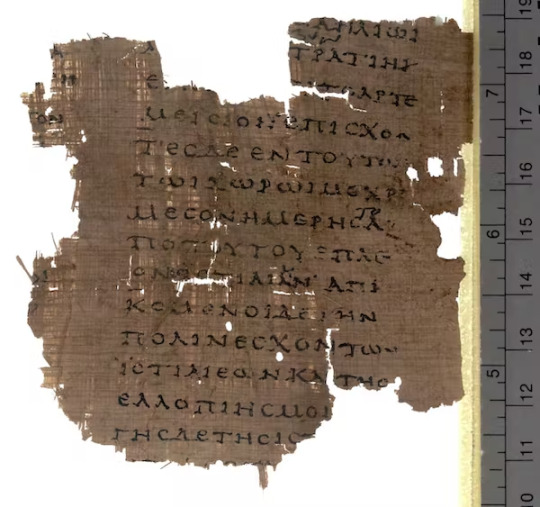
A fragment from The Histories on Papyrus dated to the early second century AD. Wikimedia Commons
All these are instances in which Herodotean inquiry – despite his own claims to the contrary – slip beyond the realm of the authentic, credible and real.
But it would be a mistake to make too much of these examples. They are memorable only because they stand in such marked contrast to the accurate pictures Herodotus sketches elsewhere of the world.
And who can say for sure that the gold-digging ants, the long-tailed sheep and the flying snakes did not, in fact, exist? Some have argued that the gold-digging ants of India were actually marmots and Herodotus applied a Greek word for ant to a creature unknown to him but reminiscent (albeit faintly) of an ant.
Other creatures, however, take the reader fully into the realm of the fantastic. In his description of Libya, Herodotus says emphatically:
There are enormous snakes there, and also lions, elephants, bears, asps, donkeys with horns, dog-headed creatures, headless creatures with eyes in their chests (at least, this is what the Libyans say) wild men and wild women and a large number of other creatures whose existence is not merely the stuff of fables.
Some of these beings belong to a different, more archaic world, where the boundary between man and beast was fluid and uncertain. We can see a whole spectrum of more or less fantastic creatures, whose ranks included the Cyclops and Sirens of the Odyssey.
Herodotus accommodates such creatures in the absence of better information, but at the very least he feels the need to explicitly confirm their place in the new world of critical inquiry.
A special category is reserved for the most startling aspects of the world. In the Histories, the concept of the wondrous (thaumastos/thaumasios) is applied to those aspects of the world which at first defy explanation and seem to fall outside the laws of nature.
A floating island is a wonder; lions who attack camels but no other creature in Xerxes’ entourage – another wonder; the complete absence of mules in Elis – again a wonder. Ultimately, many of the phenomena Herodotus considers wondrous ultimately have a rational explanation of cause and effect. Others turn out to be divinely inspired.
Eternal themes of power, greed and fate
Beyond the question of whether any (let alone all) of the Histories’ events occurred as Herodotus relates, his stories share a common humanity. The examples of all-too-human foibles and traits like overconfidence, greed and envy but also of fate, luck and fortune reverberate down the ages. Through these stories the Histories still speak to us, 2500 years later.
Traditionally, the Histories were dismissed as anecdotal. Herodotus was seen as lacking gravitas and not on par with Homer, Euripides, Thucydides, Cicero and their like. Consequently, the Histories were not considered central to the humanist canon. Over the last three decades, however, this has changed; Herodotus’ Histories are now widely regarded as a foundational text in the Western historiographic tradition.
Classical scholars have discovered that the work has a coherence after all. Unity between the digressions and the main narrative emerges on a level other than plot: by theme. Many stories in the Histories are case studies in the nature of power.
It is not Everyman who makes history in the Histories: the focus is squarely on those at the top of the game. Yet in most instances the rise to power is followed by a sudden and catastrophic fall.
The reasons are always similar: power leads to excess. Blindness to the limitations of human action incurs the downfall of mighty kings like Candaules, Croesus, Cambyses and Xerxes. The condition they suffer from – the Greek word is hybris – is depressingly modern and familiar.
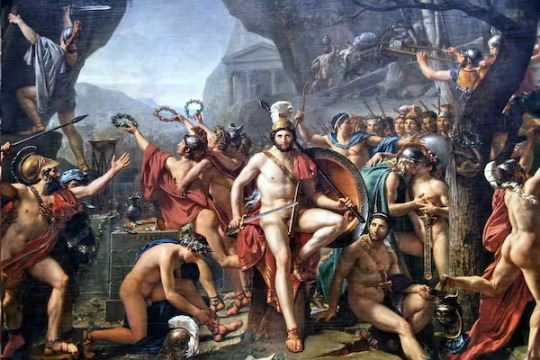
Jacques Louis David’s painting of the Spartan king Leonidas at Thermopylae - an event described by Herodotus. Wikimedia Commons
The Histories are a compilation of stories packed into each other like nesting Russian dolls. Successive stories share with each other – and the larger historical narrative of which they are part – the same insights, themes and patterns.
Once you can read one, you can read them all. New insights emerge from the way individual stories play with the formula, highlighting different aspects of the theme.
As tales of the nature of human power, the “digressions” speak directly to Herodotus’ core theme: the rise and fall of all empires, in particular the Persian Empire and its spectacular defeat by the much smaller Greek contingents in the Persian Wars.
Yet the Histories are not merely a historical source for the Persian Wars. Herodotus dwells extensively on the pre-history of the conflict and touches on the cultural and ideological issues at stake.
All this is set on the broader stage of the ancient world and includes geographical references, climatic observations, flora and fauna as well as notes on differences in the customs and lifestyle of Greeks, Persians and other peoples.
Thanks to this broad focus, it is not hyperbole to say that, in a profound sense, the Histories are about the entire world as it came to be understood and mapped out towards the end of the fifth century BCE.
Wonder and discovery
The Histories stand at the transition from an older, mythical worldview – that of the heroic or archaic age as represented in Homeric epic – to a new, classical outlook that manifested in the exacting mode of enquiry into the workings of the world.
The name for this form of investigation – historia – did not yet mean “history” as we know it; it simply meant, in a general sense, “critical enquiry”. Herodotus occasionally mentions consulting written sources, but he does so mainly to distance himself, his method, and information from other authors, notably Homer and the poets.
The most subtle feature of the Histories, perhaps, is the profound sense of balance that pervades all aspects of the cosmos. In the world of Herodotus, any excess is ultimately corrected: what goes up must come down. This applies to individuals, to empires and to peoples.
The divine is central to Herodotus’ view of the world: the gods guarantee a perpetual historical cycle. This dynamic ensures that imbalances of power or greed – the too-much and the too-little – ultimately level each other out.
The traditional gods of the ancient Greek pantheon are still very much alive in the Histories. Yet in contrast to Homeric poetry, they no longer intervene directly in the world. They have receded to a transcendental distance from which they oversee and steer the workings of the world.
We may no longer share Herodotus’ view of the past, yet we delight in the richness of the world he sketched. Its stories, landscapes, characters, and insights into human nature linger long after the reading. What makes the work stand out above all is the Histories’ sense of wonder and discovery. Herodotus’ Histories remain a classic testament to the pleasures of researching and learning.
All translations are from: Marincola, J. (1996) Herodotus: The Histories. Revised edition. London. Penguin Books.

Author: Julia Kindt
Associate Professor and Chair of the Department of Classics and Ancient History, University of Sydney”
Source: https://theconversation.com/guide-to-the-classics-the-histories-by-herodotus-53748
I have some indications that Pr. Kindt is politically on the Right and, therefore, our overall views differ a lot. However, she is a good classicist and this article of hers is an excellent introductory text to Herodotus, despite some minor objections to or differences of emphasis with it that I may have.
4 notes
·
View notes
Text
TÚATHA DÉ DANANN - March Update & Report.
Hello everyone,
it has been quite a while since we made an official announcement, since most things are currently happening on Discord, but we felt obligated to report the newest changes here as well!
✦ FIRST CHANGE: SOFT ARRIVAL SYSTEM.
At the beginning, members would have to wait for their characters to be approved to write. We have changed this and decided to implement the Soft Arrival System. Characters on the waitlist, that have now the Status PENDING, and have been reacted with a green checkmark, have been approved to the group and sorted into a room.
Once we collected a fair share of members that have passed the soft arrival process, we will make or usual Major Arrival Announcement, and any pending characters will be listed for all to see who new has joined, while some have snuck in in the meantime.
We implemented this system solely to not keep people waiting, while our schedules could be very stuffed with other matters.
✦ SECOND CHANGE: TUATHA SOCIAL.
Tuatha Social is basically the In-Server Microblogging Platform for the citizens. Every member can make their own account and post their In-Character activities, pictures, poetries, and whatnot.
✦ MINOR CHANGES:
February Activity Check: Since February has been quite a difficult month for some of us, we decided to sleep on it and resume it for March.
Spring Cleaning: Once in a while we do a little spring cleaning on the server and remove DMs and threads of people that have left or muses that have been dropped.
OOC Bot Arcade: Mod Anemone is working on bringing some game bots in the server. Nothing too big, but still worth mentioning.
Updates on the Character and Canon Caps: The current character cap is 15, while the canon cap has been raised to 5.
Ship wall: The ship wall has been made interactive and is now a google doc! Members can add their own ships if need be, add planned ships or hinted/inofficial ships and more!
✦ FUTURE PLANS:
New Event: I don't want to spoil too much about the new event, all I can say, however, that it will be a little darker than usual, and it will also be a little lore-related. More about that when the time is come. The event is set to come online sometime in the Month of March.
New Area/s: One area is currenly planned. It is not going to be a residental area, but more of a nice hangout spot.
More lore-related events: Tuatha Lore has been in the making for months now; and we want to implement more things while at it.
✦ FINAL WORDS:
We have been sitting still for a while and enduring some rule breaks in our server for the past couple of weeks. While we do not want to point our fingers at anyone or get too much into the context, it left a little aftertaste in the tongues of members and Mods alike, and Mods are therefore obligated to no longer disregard such behavior of our members.
We Mods try our best to not turn Tuatha into a non-toxic environment, yet we do not endorse any potentially or alleged toxic behavior of anyone who is part of the group.
Things can be discussed and communicated, but it is wrong to assume that communication happened, when there is no trace of it whatsoever.
While we heavily rely on communication and proper plotting between members, we wish to ensure that if any negative behavior of any of our members regarding that or other issues should be addressed to the Mods immediately.
Thank you very much, and enjoy your day!
1 note
·
View note
Photo







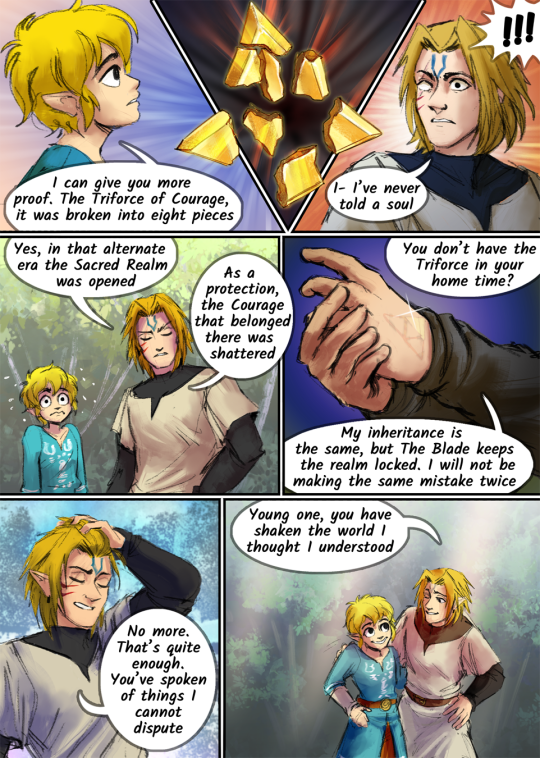
Timeline talk1
<< Previous Next>>
Based on these guys] [#LinkedUniverse ] [Archive]
#linkeduniverse#Sorry ppl for the long w8 in recent updates#this essential worker is ready to keel over#i need a break before i break#No time for answering Qs but#sudden influx asking for my specific opinion so here it is#While it's true that there will be some sweethearts in LU eventually#all other relations major and minor characters alike#are about Family Friendship & community#not shipping#not shipping wars#Thank you to those who respect that#this comic exists and continues b/c of fans like you#you have my deepest sincerest gratitude#there you have it#some better news:#we are so close!#hype
7K notes
·
View notes
Note
How do you feel about other ships that could potentially threaten Knightfall? Theres the possibility of them pushing White Knight since they're the only characters at the moment who aren't paired up yet but some people are also suggesting that Silent Knight is also possible because both Jaune & Neo have lost a partner and think Jaune will help Neo with that but theres the other possibility that Rose Garden is just a red herring like Black Sun and they were preparing for Lancaster the whole time.
Sorry if this turns up in the ship main tags. I censor ship names in the body of text to stop that. Tumblr can be a bit silly sometimes, but I'm a Jaune/Cinder shipper and I only speak of Blake/Yang and Ruby/Oscar positively here.
Thanks for your ask anon, it's kind of a big topic and this post got very long but I hate using cuts because they're so annoying (for me as a reader). Hope you enjoy.
This is where I started writing and I was so salty:
Jaune/Neo is not remotely a canon possibility and it's absurd to consider it, I'm shocked it's taken seriously at all and Jaune/Cinder is treated like a crackship.
I get that Neo is sort of a cult favourite, but don't attribute narrative importance to her where there isn't any. It's fine if you ship it, but I'm discussing canon here!
If anything I think her most important arc is obviously in relation to Ruby (forgiveness arc in the Fallen Place?) and her fractured partnership with Cinder is a dark echo of Ruby and Weiss, as @branwyns has pointed out. So, in how she's been brought back, it's in service to Ruby's struggle.
I also don't know what position Jaune's going to be in, if he's going to be able to offer Neo anything when he's sort of in the middle of an identity crisis. If there is anything there, though, I don't see how it's suggestive of a romance, especially given that Neo's a minor side character. Jaune's a very important character, he's one of the two major male protagonists, his love interest has to be someone important.
I wouldn't call Blake/Sun a red herring as such.
I think it's a childhood romance alike to Jaune/Pyrrha, Ruby/Penny which doesn't survive, and toys with anime tropes. Like Jaune/Pyrrha isn't really fairytale True Love and everything is sad, Ruby/Penny doesn't really happen because the shoujo love interest has bigger things to do (also her Snow Maiden allusion is another post, but the Snow Maiden dies when she finally truly loves someone - Winter, platonic in this case), Blake/Sun ends up being a friendship because it doesn't have, again, intense fairytale True Love (and in a lot of ways I think Blake/Sun is similar to Jaune/Pyrrha, but whatever), and so on and so forth. Jaune/Weiss is also the aborted childhood romance. So on and so forth.
I think that Blake/Yang is probably the romantic key to understanding the rest of the ships, which is that it's a) intense and vulnerable, b) answers thematic questions in the series (Salem/Ozma, Raven/Tai so team STRQ), c) directly plays with the Beauty and the Beast intertextuality and d) also has all of that magical colour matching and union of opposites. Most importantly, I get the sense that the Beauty and the Beast it plays with in the context of the romance is the older, extant French textual source (Beaumont).
The Jaune and Ruby friendship is one of the things I really like in the show, and no, I don't think they're setting up for a romance on that front. Whilst him mercy-killing Penny can lead to some dramatic angst to fulfill criteria a), I think here it's more to suggest their ideological split as respective leaders. In terms of b), there might be more argument here, but then again I don't think Tai and Summer were all that romantically involved and there was sus stuff going on with Ruby's conception. (A baby born of utilitarian need who then becomes dearly loved/must draw on the memory of her mother to use her inherited power is very thematically ironic and interesting).
And on that front, Ruby and Oscar are a 50/50 Salem/Ozma split respectively, whereas pretty much structurally Jaune is a straight up Ozma and Cinder's a straight up Salem, which again, is why they pair better if you're addressing that.
In terms of c) they share no intertextuality. It might be argued on this front Ren and Nora don't, but in their case I'm pretty sure their intertextuality, like the childhood romances, is anime itself, and they're the one endgame romantic example (but involves a reconstruction of the trope with Nora's separation).
And if we're going Jungian, Jaune and Cinder are Ruby and Oscar's archetypical Shadows. That's more evidence for that pairing up.
Regarding the canonicity of Ruby and Oscar, well, a) there's now separation and intensity given the end of V8, with potential Cupid and Psyche elements b) I'm not even sure if I have to cover how they answer Salem/Ozma as fluffy happy children meeting again and fixing the mess, also I think Ruby getting a happy ending answers Summer's bad ending, c) intertextually, the Little Prince (one of Oscar's allusions) loved a rose. The RG's have way more on this than me but this alone is enough. Also d), which is a lesser point, red/green and silver/gold are match lol. No one else pairs with her silver like that.
So yeah, I think RG and Knightfall will probably happen in respect to one another, alike to their confrontations in V5 being very similar.
Now to address Jaune/Weiss. I have some complicated feelings about this topic because I have read meta which addresses the alchemical element of this pairing, but to be quite honest I don't really want to stir up drama in terms of how I disagree with that. More prominently I want to point out that two major Jaune/Weiss interactions both feature Cinder and it's very very suspicious to me. This could be a separate post and I have posted about it before to some degree, but I sort of think Jaune/Weiss might actually be the red herring.
Of course, a lot of people who aren't otherwise interested in their characters or only just a bit take this as totally endgame, and if you have a different opinion you're probably just a crazy shipper. Whilst I am crazy, I think that framing Jaune/Weiss as the only reasonable narrative answer misses a majority of the thematic concerns in the show.
Okay, I'll just put it in this post: Jaune fully realises his Semblance when he saves Weiss. It's a big moment, right? This should basically indicate to us that they'll end up together. Let me readdress my criteria: a) he saves her like he couldn't Pyrrha, so maybe fulfills vulnerability/intensity, b) Weiss is a Salem/Ozma split, Jaune's more of a straight up Ozma; Weiss is a STRQ Qrow, and Jaune's a Tai... c) no intertextuality, other than maybe Jaune being the Huntsman in her story. Blake has a few Beasts, so we can double up on the Huntsman front (Weiss is both Snow White and a Huntress, and she has her own knight). In terms of d), one of the lesser points, their colours don't go together.
So I'm just going to supply these screencaps:

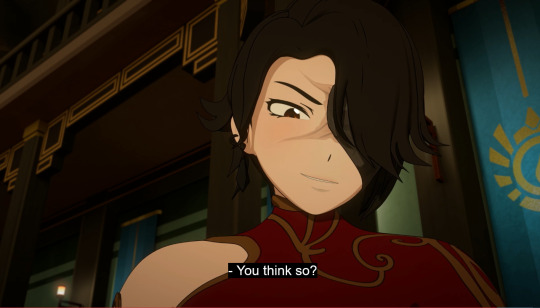
Jaune never mentions Weiss in particular. Not necessarily a huge deal: I'm contrasting this with Blake and Adam, and one of the things that really made me convinced Blake/Yang was a thing
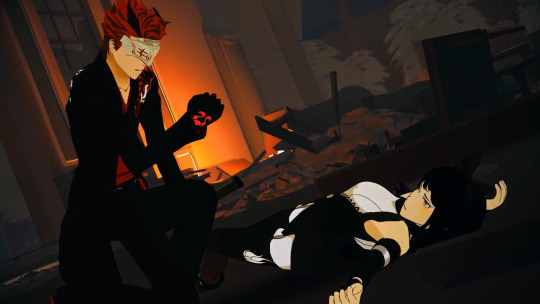

Adam, the sacrificial bull (I'm not sure if the Campbellian bull-leaping in V6 was intentional, but if it were, then it was a sacred marriage for Yang and Blake) is not the same as Cinder. I think the contrast is purposeful.
I think there might be some intentional foiling with Blake/Adam, where Adam is the straight up irredeemable enemy love interest and Cinder isn't - like, the way she responds to Emerald and Mercury leaving is not with possessive jealousy and murderous rage.


Going back to the big daddy, Salem/Ozma, as above. Again, I view Jaune/Cinder as a regenerative answer to Salem/Ozma.
Anyway, Cinder targets Weiss. Earlier in that sequence, Jaune doesn't make specific mention of Pyrrha. Cinder only has reason in this sequence to target an apparent love interest because that's her narrative role to do (and what everybody expects).
It's probably easy to brush off Cinder being involved as just the baddie causing trouble but basically the entire thrust is Jaune and Cinder's interaction; Jaune and Weiss don't really have much to say to each other and it doesn't carry the same romantic relief Blake and Yang do! If anything, I think confronting Jaune's self-sacrifice, Cinder's worldview, and their respective spiritual evolution and subsequent fall is like, the whole point. There's nothing that really feeds into Weiss' character arc here, that's why I remain puzzled; it's a big deal for Jaune, because he learns how to be protective, and it's a big deal for Cinder, because she's had the whole, 'They matter!' thing thrown right in her face, and also she's using a sword like Rhodes so she's in a bit of a personal crisis.
The underestimated thing here is that conflict with his anima here leads to him realising his Semblance, which is the purpose of anima confrontation (spiritual evolution)... so in the background there's Jaune/Cinder stuff going on. Which is why, given what they did with Blake/Sun, Blake/Adam, Blake/Yang, I'm sensing something odd here.
The second sequence, which notably involves Jaune and Cinder's fight over Penny, of course has him kill Penny to stop Cinder hurting Weiss again. That should be indicative, again, of Jaune/Weiss. But I'd expect there to be something again here, but instead the focus is on Jaune and Cinder. I don't know how else to describe this, but all of the angst and pain of Penny is not a concern in Weiss' character. Weiss knows what's happened, though, and it's fair to say she'll be involved in helping establish what happened with the others, but how that goes remains to be seen and is a totally separate topic. But if we're leaning hard on Tai and Qrow there, well, Tai and Qrow clearly have something going on in the sense of a personal dispute.

But the part I want to focus on is where Jaune is helping Weiss to safety which has, um, how shall we say


someone looking verrrrrrrrrrrrry upset - borderline jealous? - and I get that Cinder doesn't like Weiss because Weiss represents all of the failings of Atlas, but wow, that's insanely clever to make your romantic rival also represent everything you hate and rebel against.
You could argue here if you're a naysayer this is about her fucking with Winter, but Cinder's made no indication here that this is about fucking with Winter. This seems personal.
It would probably be easy to say that this is just setting up Jaune/Weiss with unrequited feelings on Cinder's part for Jaune, and then some confrontation ala Adam, but Cinder's not abusive towards Jaune. Also, what would unrequited feelings narratively achieve? In the case of Blake/Sun, Sun's feelings lead to a type of selflessness which helps him mature, and in the Vacuo arc I think that will become relevant, especially if you-know-who's a Maiden. In the case of Jaune/Weiss, his unrequited feelings for her are meshed with the pressure he feels to fulfill a particular masculine ideal. (Which is more evidence against the ship).
Cinder and Jaune have never been in a relationship, there's no trust to break, the only hurt between them is as enemies, and even then when they actually fight they barely hurt each other. In some ways I think the writers are sort of aware that like, yes they need to be enemies but there are probably people who would be upset if they did actually meaningfully harm each other directly, beyond Pyrrha and Weiss who serve narrative roles.
Jaune only chips her mask. She breaks his sword. That's the real harm they do to one another, it's transformative.
So if Cinder's being set up for a redemption arc where Adam isn't, then I think it's probably fair to argue that Jaune/Cinder is being set up as a positive relationship.
Also on this front, Adam was not one of the lead antagonists, he didn't carry the same special narrative role Cinder does as Ruby's Shadow and the Fall Maiden. So to say that her story will play out exactly the same as his when it's been contrasted purposefully is just silly. I mean, he has that big manipulative reveal of his scars to Blake, and it's obvious to us he did that to her a lot.
Meanwhile Cinder's own past, what others know of it, is used against her by Salem and Watts to manipulate and hurt her. So yes she's a very naughty villainess, but she's not an Adam.
I would make the argument here that of the three pairings - Blake/Sun, Blake/Yang, Blake/Adam - Jaune's equivalent three - Jaune/Weiss, Jaune/Pyrrha, Jaune/Cinder - follow a similar, but slightly different pattern.
Firstabble, the anime trope romance which is reconstructed: Jaune/Pyrrha, Blake/Sun
Secondabble, the historical romance which was one-sided: Jaune/Weiss, Blake/Adam
Thirdabble, the endgame fairytale true love: Blake/Yang, Jaune/Cinder.
So yeah I think Jaune/Weiss is only endgame if they decide to be really boring, play into vomit 'nice guy waiting for girl' trope for some bizarre reason that the show has broadly rejected, and decide to break the entire thematic and mechanical thrust of the show.
Let me quickly fit Jaune/Cinder into that earlier ship paradigm: a) very very intense and vulnerable, b) they are literally just straight up Salem and Ozma in reverse, they're even framed the same way, and also Raven/Tai, not explaining anymore but that's the same as Blake/Yang too, c) intertextually, Jaune's been set up as somebody's Prince Charming, and the bloke who cheated into a fucking Huntsman academy and was ostensibly a shit one being the real and best Huntsman/Prince for Cinder's story is endlessly, endlessly amusing. There's also all of the Rhodopis stuff (alike to Blake and Yang's allusion background) I have gone on about ad nauseam and then Jaune's own Joan of Arc influence involves crowns and a saint whom she hears from breaking out from the belly of Satan to free herself, so like, please do not get me started. Then, d), which is the lesser point and why I'm including it but not making a big fuss, Jaune and Cinder's colours oddly match, but it depends how hard you lean on her pin being indicative of her future colours (purple and blue), given that she's transitioned into black. But the orange and blue eyes do match so you can't take this away from me.
I also think that, like Blake/Yang was a pleasant surprise, Jaune/Cinder has the potential to be a pleasant and interesting twist. It's just the most interesting story you could tell, and I think we're due for something transcendentally happy, since that's the direction the show is going in. To be honest, I think that this is the long way around to Salem's happy ending. It's fitting to me that analogues of her in the story also fulfill that in some way.
So yeah I actually think the reason Jaune/Cinder has a chance is sort of exactly because people underestimate it and don't expect it. It makes perfect sense, though. It's very very very clever and I like it a lot.
I mean, where are we right now in the story? Cinder has recommitted to trying to be clever and smart and manipulative, even turning it on her own master. Jaune's mercy-killed Penny, the healer with bloody hands. There are some peope who think Cinder's redemption arc has been rejected, some who think Jaune won't have any angst or pain. I think there's something interesting to do with their respective characters from here. If they redeem Cinder, it almost definitely has to involve him. Everybody before him, Rhodes, Salem, Emerald, Mercury, Watts, only ever wanted something from her or of her. Staying quiet and doing as she's told, and enduring imprisonment. Imprisoning her again under the guise of a false freedom. Safety, food, love, shelter. Watts, his own motive and ends (no idea how people think him interacting with her was the point of no return for her morality). All of these failed attempts should indicate she can't be redeemed, right?
After all, how many tried to climb the tower to free the maiden?
But all of them only wanted something from her: her hand, the riches, the glory. There was just one knight who didn't care about any of that, and only did it because it was the right thing, and then they fell in love.
Which pairing am I talking about? (:
11 notes
·
View notes
Text
Saturday 5/4/22 - Media Recommendations #29
I know I only just did one of these yesterday, but I suck at keeping finished things to myself. So I'm posting it now.
A lot of my "recreation" time these days, I spend working on the D&D campaign I DM, so it's made sense to get back into a D&D Podcast I kept up with a while ago, and start to explore the extra fandom and media surrounding it.
So this week, I'm going to talk to you about a short, R Rated animated series about Dungeons and Dragons called The Legend of Vox Machina.
The Legend of Vox Machina
Critical Role
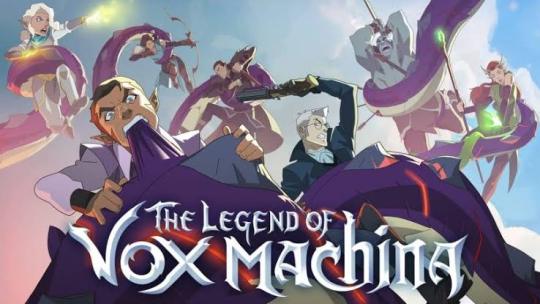
Dungeons and Dragons has been a huge part of my life the past couple years. I play with my closest group of friends and its great that what's essentially playing make believe with rules is an acceptable form of adult bonding. As I became deeper involved in the intricacies of the lore and the strategies of play, I started paying closer attention to media related to D&D.
A group of voice actors, DM'd by Matt Mercer, have been broadcasting their D&D campaigns as a longform web series called Critical Role, since 2016. Now up to their third campaign, Critical Role has grown into a brand unto itself, with merchandise, supplementary comics, and even official D&D 5th Edition source books. This renown has culminated in an Amazon Prime animated adaptation of part of the first campaign, Vox Machina. And I loved it.

The Legend of Vox Machina is every D&D player's dream, a cinematic representation of the adventures a group of friends have built together. And it really does feel like that. A worrying prospect going into the series was that the adventure would get... epic-ified. Fantasy tales tend to get reflavoured to be more grand and chivalrous when adapted, and in my experience, that is not D&D. D&D players are crass, opportunistic, strategic, and... they make mistakes. And this translates very well into this The Legend of Vox Machina.
Briefly, without spoiling too much, this 12 episode run follows a group of wannabe world savers called Vox Machina, who had yet to make a name for themselves partially due to their own incompetency. The group fight monsters and men alike in the name of peace, but their methods and attitudes in civilisation make them hard to get along with. The story culminates in the resolution of one of the main character's backstory, and by the end of the season, the group has grown to be favoured by the kingdom, and slightly more respectable.

You can see in the moment to moment action and dialogue where the animators have directly translated the roll of the dice into how a situation unrolls. Good intimidation and performance checks translate into the player characters successfully winning over the people, and failed deception and slight of hand checks result in those characters being called out on their shit. Although players may design their characters as built for adventurer, nobody is on their A-game 24/7.
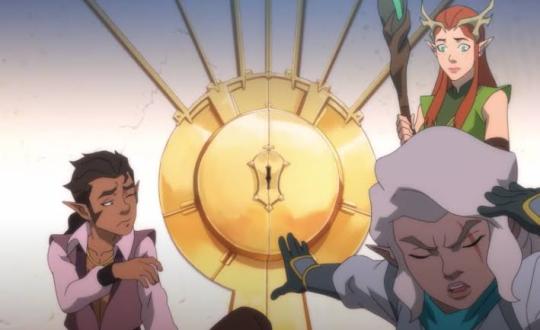
Even more so than ability checks, the failures and successes of combat rolls are used to choreograph nail-biting and fun action sequences. Good rolls are depicted as the players overcoming adversity and honing their skills, while bad rolls are depicted as having the odds stacked against them, something went wrong in the moment, or the enemy is more formidable than they thought. And critical hits, a natural 20, comes through as the fates favouring good, a deus ex machina, that comes through just as the good guys needed it most.

The visual design is a fun and elastic. Characters are expressive and energetic, and the effects of spells and action are both easily to follow and visually exciting. The world is lush and beautiful, and, as envisioned by Matt Mercer in his original campaign, varied in vistas and cultures. All player characters are voiced by the players who originally played them, which lends a unique authenticity to their depictions. Because who knows a D&D character better than their own player? Additional roles of minor and major characters are voiced by a variety of other guest voice actors, and no character feels like the DM putting on a bad impression. Every voice actor, artist, animator, composer and producer who put their all into this work deserves major props for the fantastic final product.
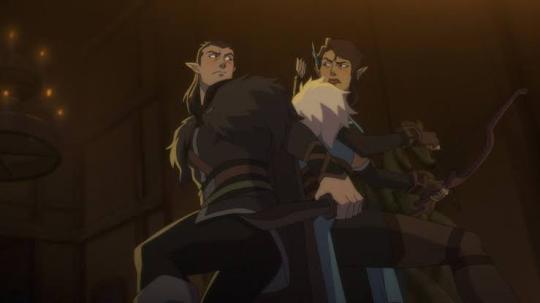
If you have been considering watching The Legend of Vox Machina but are afraid you'd be missing context from Critical Role, don't be. I had only started seriously consuming Critical Role last year, and am only up to date on the 3rd, most recent campaign, and went into this series with little to no knowledge on the original campaign and its characters. And I still enjoyed it immensely. If you are a D&D enjoyer in any capacity, you should watch The Legend of Vox Machina. You'll love it.
youtube
#Youtube#blogpost#blog#media recommendations#anime recommendations#animation recommendations#critical role#vox machina#the legend of vox machina#d&d#dungeons and dragons
17 notes
·
View notes
Text
Major Symbolism in Episode 20+21 (Another MugenxFuu Post)
Episodes 20 and 21’s series of images has been going through my head a lot recently, and I think that it is about time I rant about it.
I’ve written before, how Sara is a symbol of a maternal figure for Mugen. But today, I’m gonna go into something else…
Episode 20’s series of images alludes to Mugen and Fuu not only having feelings for each other, but also the concept of marriage, parentage and the idea of being abandoned. A lot of these details bridge and connect with multiple parts of the episode.
The Sad Bride
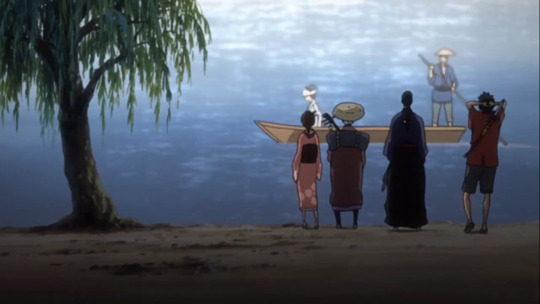
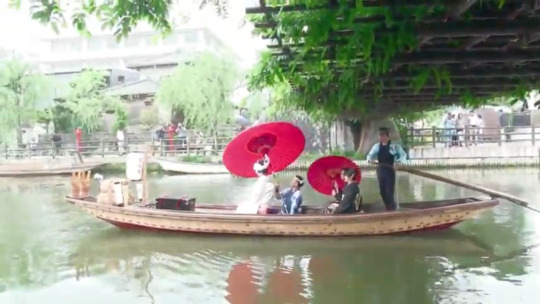
The woman upon the boat is dressed in a traditional uchikake wedding kimono. What is happening is “Yomeiri-bune”: a traditional Japanese bridal procession on a robune rowboat.
The robune boat carries the bride’s household possessions at the front of the boat. The bride sits behind the possessions. Behind her, the bride’s two parents sit, wearing black. This boat carries the bride across the canal, to her husband. This traditional procession is still held in one place in Japan: Ibaraki during “Suigo Itako Ayame Matsuri”, or the “Iris Festival”
Here is a video of it: https://www.youtube.com/watch?v=ApIeJ384oDo
There are some key details about the bride in the scene of Samurai Champloo. While I think it could be a tale of Sara’s life...I think this is more related to Fuu’s future.
1.The bride has no household possessions. Fuu also has no household possessions of her own. The two women are incredibly poor.
2. The bride has no parents seated behind her. Fuu also has no parents to send her off and celebrate her marriage someday, as her father abandoned her, and her mother died of illness
3. There is a willow tree to the left of the scene. This one may not be major, but willows are symbols of grief, and in Japanese culture, are thought to attract ghosts. For such a sad symbol to be shown in a composition of a marriage seems intentional.
4. The bride is not smiling. Should a bride not be smiling upon her wedding day? It is supposed to be one of the most joyous moments of a woman’s life. She must be unhappy about the arrangement. This exact composition of Fuu’s unhappy face can be seen later, where Fuu is shown in front of glittering blue water. She must contemplate which of her bodyguards she will give up. But I’ll get more into that later.
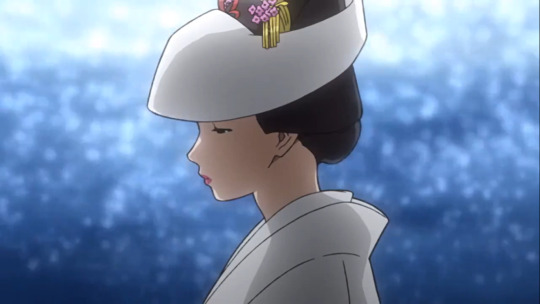
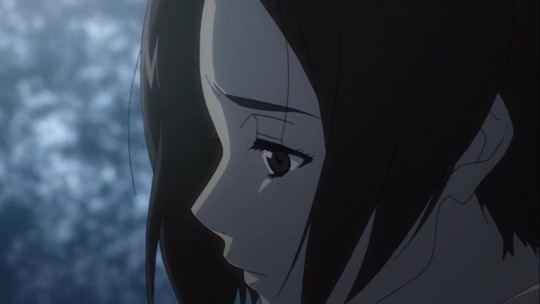
Notice also, in the composition of the scene, how Fuu is on the far left, where the bride is. Sara and Jin are standing close together, where the parents ought to be seated. Mugen however, is a far distance from them all.
Sara is clearly a maternal figure in the episode, as her entire story concerns her child. Jin also has some parallels to the Sunflower Samurai, and plays a very fatherly role for Fuu throughout the series. I wonder if this position is intentional.
At the end of the robune procession, the boat delivers the bride to her husband. When a woman is given away to her husband, she is also saying goodbye to her father and mother.
There seems to even be a symbol of this.
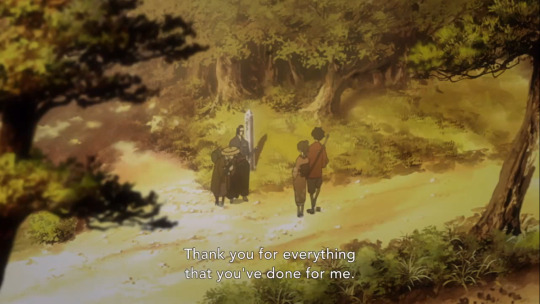

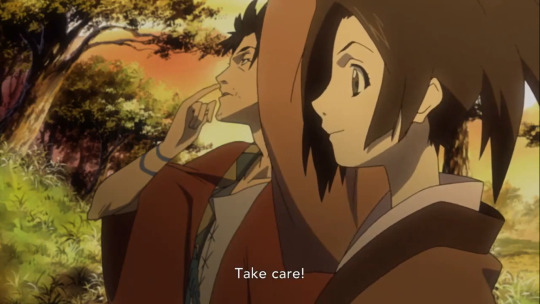
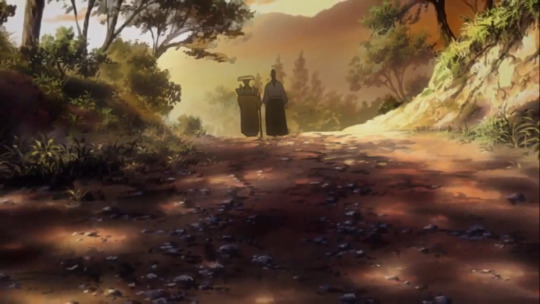
But it is not to say Fuu wanted to give up Jin. It is clear that after Jin leaves with Sara, how upsetting it is for Fuu. She breaks down into tears. Though, it is important to note how childish these tears are. It is a comical scene, where Mugen gets frustrated and stomps off. It is nothing like the painful moments that Fuu cries when she thinks Mugen is in danger/dying (In episodes 14, 21, 25 and 26).
This seems to be Fuu clinging childishly to the closest thing she has to a father figure (Jin), similar to how this whole journey is her trying to find her father: the last remnant of her past.
The Mother and Child
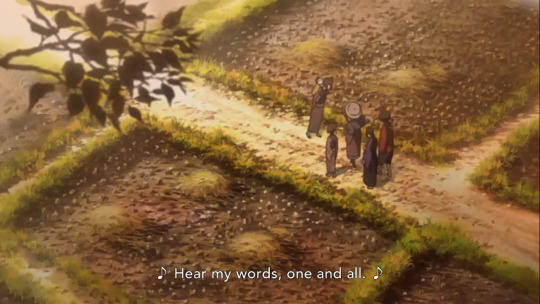
While walking, the four travelers pass a mother carrying a child. The father is nowhere in sight. Again, this is an allusion to Sara and her son. But it is noteworthy that the only character to look back at the mother and child is Fuu.
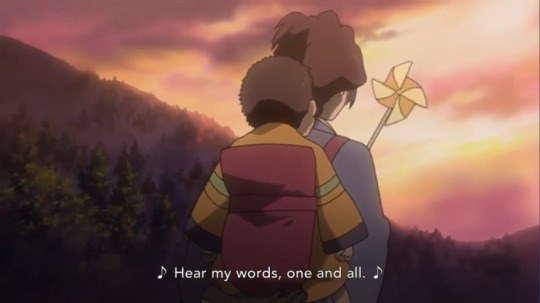

The mother has light brown hair, like Fuu. The son has black, wild and unruly hair and orange clothes. More on the orange later.
The next symbol shows how this is not only about Sara...but about Fuu contemplating a future: the fear of being abandoned by a husband and left with a child alone, the same as her mother was.
The fear of being abandoned by Mugen.
The Pinwheel
The mother and child have a yellow pinwheel.
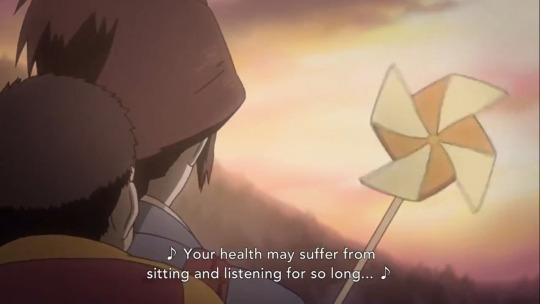
I’ve talked in other posts how pinwheels seem to be a symbol of childhood innocence, and of rebirth. However, we have seen a pinwheel in only one other scene in the series. And it is almost the exact same color. They could have chosen any color for the pinwheel, but I cannot help but feel this color choice is deliberate. Mugen flicks the pinwheel in Episode 1, just moments before meeting Fuu for the first time.
Rather than childhood innocence, this pinwheel flick could have another meaning entirely. In Chinese culture, the flicking of a pinwheel means to “turn one’s luck around”. Why this is notable, is, in Episode 1, we find out Mugen is not Japanese at all, but Ryukyuan. The Ryukyu Kingdom was a tributary state of China, before being invaded by the Satsuma Domain. For that reason, there is a blend of both Chinese and Japanese culture in the Ryukyuan Islands.
Perhaps Mugen flicked the pinwheel, as a way to wish himself good luck in getting some food. Little did he know, this meeting would greatly change his life.
Furthermore, the pinwheels start to shift into sunflowers. Fuu’s face pans across the scene, as if a symbol that she has come to a realization, or is pondering something important.
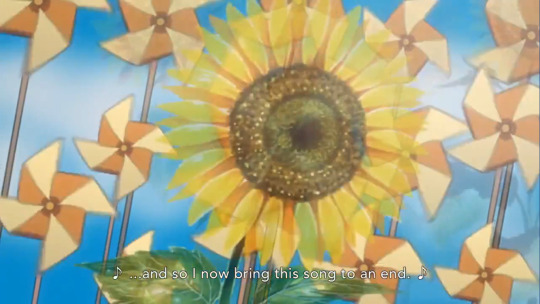
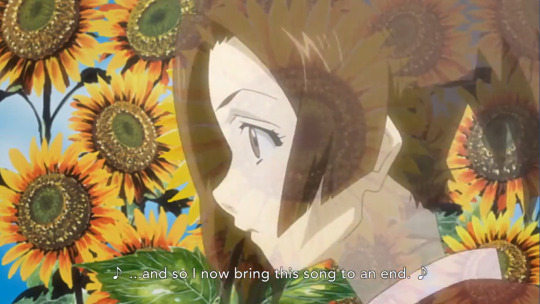
This could be a symbol of Fuu coming to a realization of her feelings for Mugen, her fear of the future, and the fear of being abandoned by him, the same as her father abandoned her mother.
This fear and realization is reinforced throughout the rest of the episode.
The Boy with the Monkey Mask
During the festival, Sara asks Mugen and Jin to pick out a gift for her son. Mugen proceeds to grab a small child, and asks what he wants.
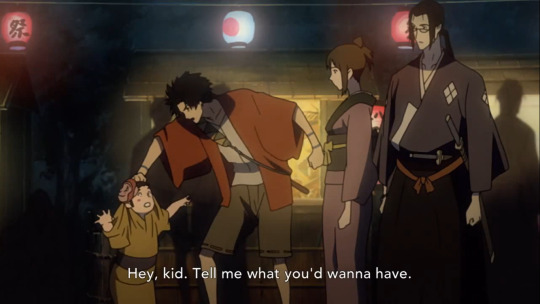
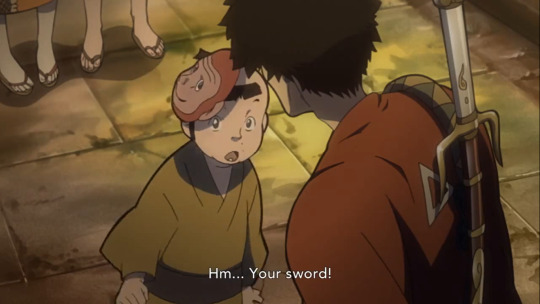
1. The child responds that he wants Mugen’s sword. He’s a little fighter.
2. The child is wearing a monkey mask. This is important because in the previous scene, Mugen, Fuu and Sara bathe in the hot spring. When Sara asks Fuu what Mugen looks like, she gets extremely flustered and proceeds to say: “Honestly, he’s less than human. He’s more like a monkey or a gorilla.”

However, we know Fuu is lying, because when Sara asks, “What?” Fuu sinks into the water and blows bubbles.

The fact that the line and the mask is a scene apart, seems intentional yet again.
3. The boy is wearing orange, similar to the orange of the boy on the woman’s back earlier that only Fuu looked at. Also, Fuu in her childhood, is seen wearing orange...and was abandoned by her father.


This boy is a symbol of Mugen and Fuu having a child together. To reinforce this is the thoughts going through Fuu’s head, Mugen asks Fuu what they should get for a boy. Fuu remembers Sara’s request of taking one of them with her. It is at Mugen’s words and her own thoughts, that Fuu suddenly runs away in tears.

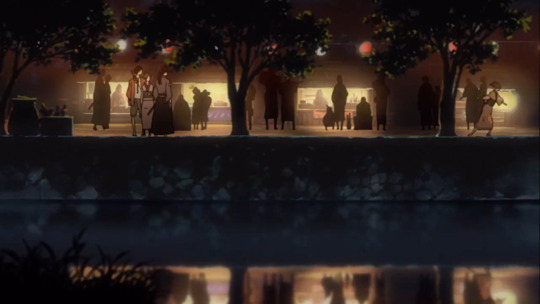
We know that she is pondering the choice Sara gave her: Mugen or Jin. We know that she knows Mugen will willingly leave her. We also know that she chooses Mugen to stay, despite this.
And this is where we see that previously shown picture of Fuu’s sad face, emulating the face of the sad bride. Fuu is afraid Mugen will either abandon her, or will not love her.
Jin is the one to chase after Fuu and appears behind her, not Mugen. He is far more reliable, and would seem to be a better husband. Fuu could very easily marry a man someday that she does not want to be with, because Mugen is not the type to marry. But despite all of this, Fuu still chooses Mugen to stay and complete her journey.
The two episodes’ composition largely features Mugen and Fuu, while Jin plays a more minor role.
Not only does she give up Jin, but also the entire Episode 21 barely features Jin. It becomes about Mugen facing Sara twice...and it also becomes about how Fuu’s love for Mugen stops Sara from killing him,
Sara’s words to Fuu
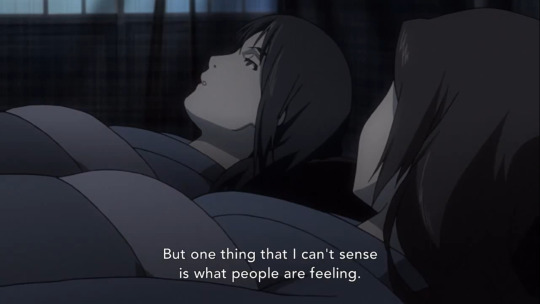

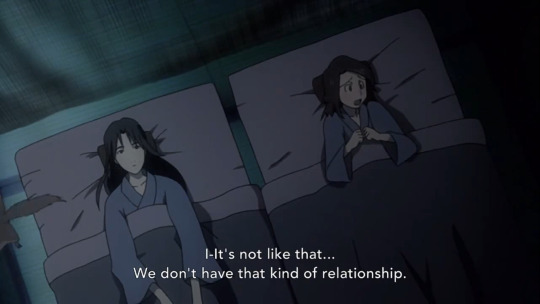

She chooses Mugen.
Sara’s Words to Mugen


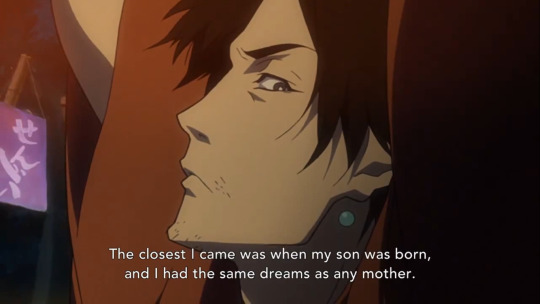
Sara tells Mugen they are alike, and mentions the closest she came to happiness was having a child. It also zooms in on Mugen’s face here.
Having a child with Fuu could be his first shot at happiness.
This dialogue completely emulates Mugen’s dialogue with another woman: Koza in Episode 14, in which she asked Mugen if he is happy now. He tells her he hasn’t thought about it. Koza then went on to say “Fuu is happy because she gets to be with you. I want to be with you, like she is.”
A Distance in Episode 20. A Closeness in Episode 21.
Throughout the episode, Mugen and Fuu are barely shown next to, or across from each other. They are always near Sara or Jin instead.
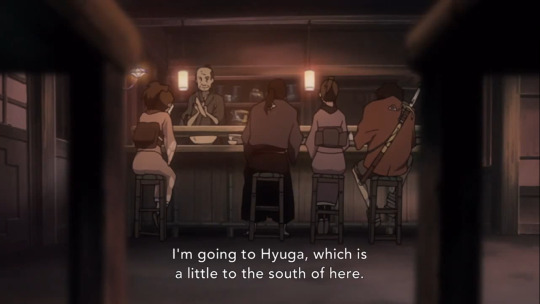
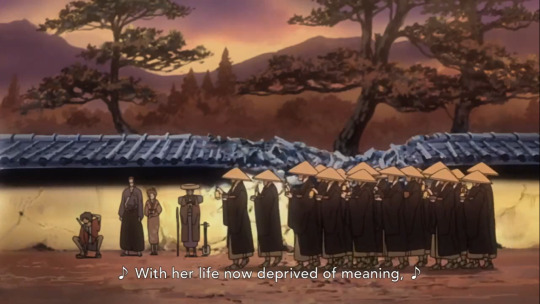
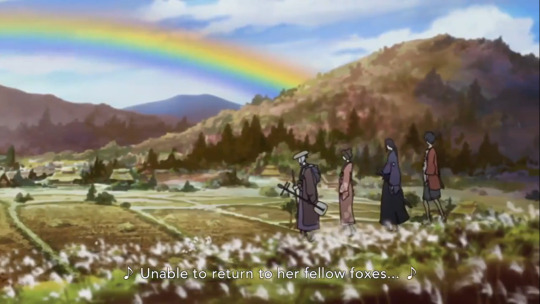
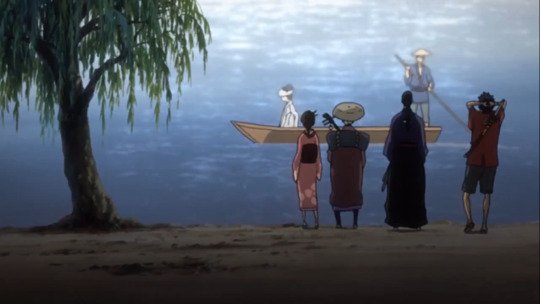
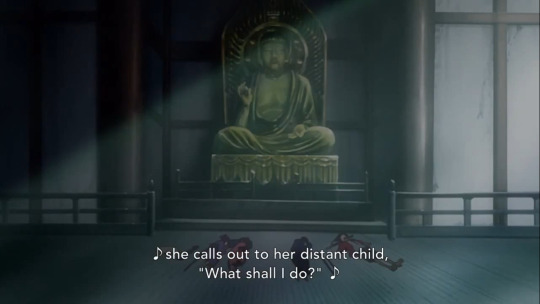

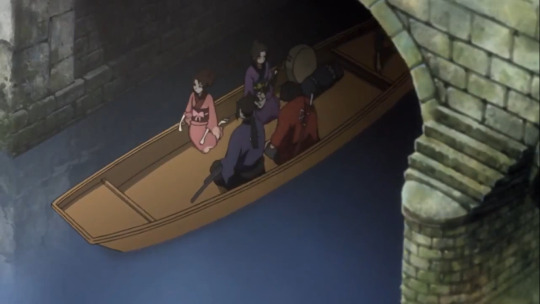
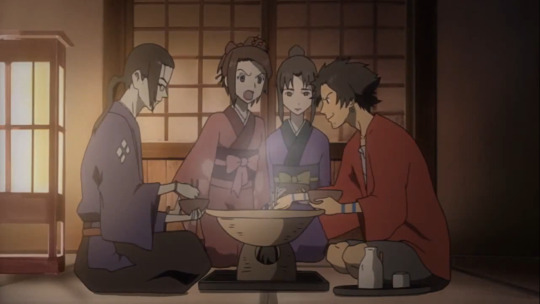
There is is a sense of a distance forming between Mugen and Fuu. But by the end of Episode 20, Fuu still chooses Mugen to stay with her. And Episode 21, they are finally close again, stuck alone together.
She throws herself on top of him to save his life and tends to his wounds which are close, intimate acts.
Other Blatant Hints
Aside from the visual symbolism in the episode, there are other clear indications of the character’s developing feelings for each other during these two Sara episodes, but not expressing them.
Fuu and Mugen see each other naked in the hot spring. This is a painfully common romantic anime trope.


Fuu gets jealous of Mugen’s attention to Sara.
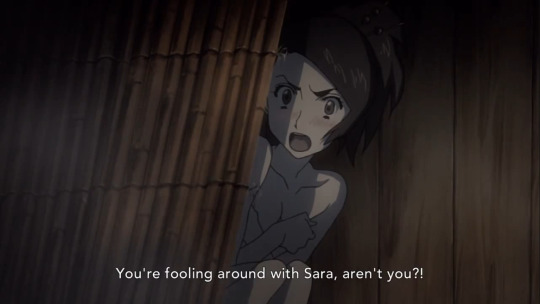

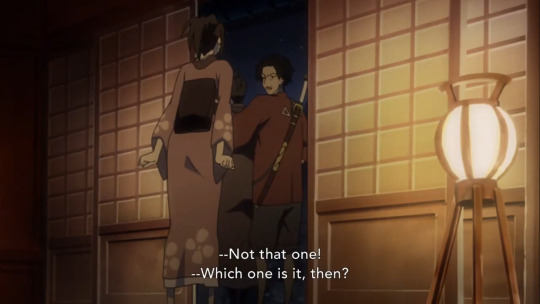
Mugen gets jealous of Fuu crying over Jin and comically stomps away. He agrees to stay with Fuu, even though he clearly could’ve abandoned her, and only claimed to stay to fight Jin. Now with Jin gone, he has no excuse as to why he’s sticking around.

Fuu’s Declaration of Love
Fuu throws herself in the way of Sara’s blade, in order to save Mugen’s life. This action was committed only mere seconds after Sara’s haunting words to Mugen: “It’s as if you’ve never been loved by anyone.”
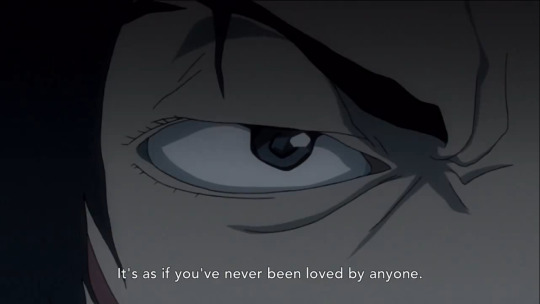
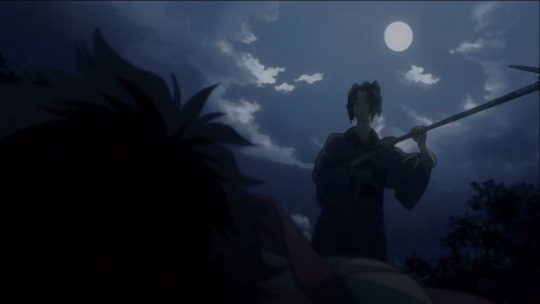
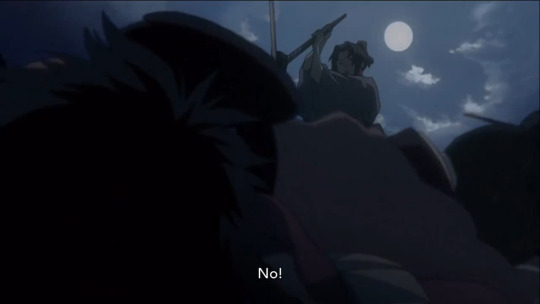
Fuu throwing herself in the way is proving Sara’s words wrong. Mugen is loved. This is why Sara gasps and stays her blade. Like her previous words, she is unable to read people’s feelings.
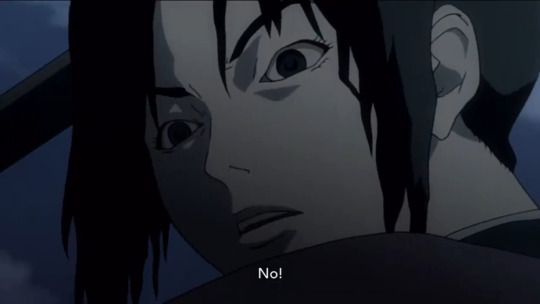
Throwing her own life in the way for Mugen’s life to be spared could have easily gotten her killed too. To me, this seems to be an allusion to “Shinju” or “Double Suicide”. Lovers’ suicide was surprisingly common in Japanese history, and there have been famous Tokugawa plays written about the subject such as “Love Suicide at Sonezaki” and “Love Suicide at Amijima”.
Conclusion
The symbols of a sad bride, a pinwheel, a child with a monkey mask, Fuu’s choice and Fuu’s sacrifice all allude to her feelings for Mugen, and her fear of an uncertain future with him.
Now, combine this giant list of symbols, with the numerous amounts of far more major MugenxFuu scenes, blatant dialogue, interviews of the voice actors and Shinichiro Watanabe, etc...and what you have is a canon subtle romance.
#samurai champloo#Fuugen#mugen and fuu#Mugen Samurai Champloo#fuu samurai champloo#shinichiro watanabe
199 notes
·
View notes
Text
FEATURE: Japanese Myths And How They're Depicted In Horror Anime

No matter the time or place, the folklore and myths of the past always persist. The same can also be said for anime, especially when it comes to horror. Certain franchises, such as Shigeru Mizuki’s classic GeGeGe no Kitaro, have solidified the omnipresent status of traditional Japanese folk monsters in popular culture. Other series, such as Osamu Tezuka’s Dororo interpret traditional folklore in relation to historical periods and changing attitudes toward religion. More recently, series from the 2010s and 2000s, such as Bakemonogatari and Ghost Stories, interpret the classics with modern sensibilities. When it comes to stories with a penchant for horror, it would be far more surprising if they didn’t allude to a shared supernatural mythology — the ubiquity is the point.

Neko-Musume on her smartphone
The best horror always tries to do something new. While creatures like yōkai (a wide umbrella of supernatural entities) are well-known among English-speaking fans today thanks to series like Yokai Watch, these re-imaginings always tend to play fast and loose with fidelity. Wouldn’t it be boring if every vampire movie started and ended with Dracula? In a 2016 interview with The Comics Journal, veteran manga translator Zack Davisson emphasizes this important tendency to re-contextualize old folklore:
“It’s a tricky question, as it is impossible to say what is ‘actual folklore.’ Vampires bursting into flame is considered ‘authentic,’ but that actually comes from the films, not folkloric sources. Folklore evolves and [Shigeru] Mizuki is an important part of that evolution. If you trace them back, most yokai we know come from Toriyama Sekien, who also just made things up. In fact, I would say that making up yokai is part of the grand tradition of yokai! If you are a writer/artist working with yokai and not making up at least a few of your own, you are missing the point!”

The original spirit gun
So that’s all to say — there really is no such thing as a definitive, one-to-one story based on centuries of tradition. Yōkai, as endearing as they are, are also just one part of the equation. Long-running anime such as Folktales from Japan and fantasy series Inuyasha-continuation Yashahime: Princess Half-Demon either re-tell or draw inspiration from that folklore. But that’s beyond the scope of this piece. Whether it be adaptations of urban legends about school bathrooms or vengeful spirits, I hope this round-up helps any casual or long-time anime fan appreciate how these series reimagine supernatural traditions.
Fantastic Folklore: GeGeGe no Kitaro & Mononoke
The late Shigeru Mizuki’s most influential character, Kitaro, hardly needs any introduction. In his book Yokai Attack! The Japanese Monster Survival Guide, translator Matt Alt describes yōkai as “the attempts of the fertile human imagination to impose meaning and rationality on a chaotic, unpredictable, often difficult-to-explain world.” Many yōkai are quite strange and sometimes even comedic. Scholar-artists, such as the previously mentioned Toriyama Sekien, are largely credited with inspiring their uncanny visual representations, making them the perfect subject matter for an accessible series.
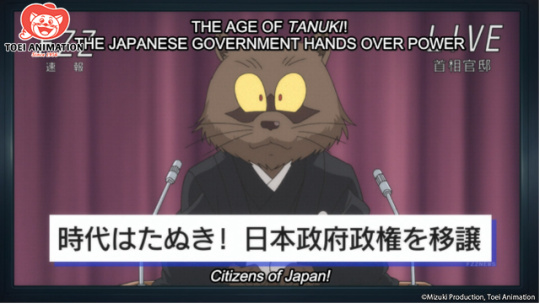
The tanuki plot world domination
The titular Kitaro himself is a half-human, half-yōkai one-eyed boy who travels between the human and spirit world to resolve monster-of-the-day conflicts with his friends. Although Mizuki’s Kitaro as we know it began serialization in 1960, Mizuki originally received permission to re-imagine the character from Masami Itō, who first created Kitaro in the 1930s in pre-war Japan. The most recent 2018 anime series re-establishes Kitaro in a modern setting, yet still adapts many of the most iconic stories. Characters such as Neko-Musume, based on volatile cat spirits called bakeneko, are updated with new designs while Kitaro mostly remains the same. Mizuki’s older creations, such as the jubokko (vampire tree) yōkai, are still featured alongside a new re-imagining of the “wall monster” nurikabe — inspired by the discovery of an Edo manuscript in 2007. The appeal of Kitaro isn’t so much the meticulous adherence to yōkai mythos, but rather Mizuki’s continual improvisation of the folklore-informed monster-making tradition.
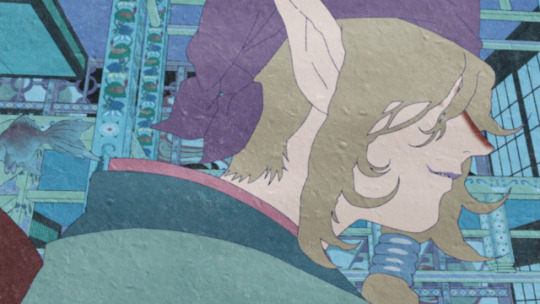
The Medicine Seller
Beyond Kitaro, other series, such as 2006’s Mononoke, dedicate entire storylines to a wider category of ayakashi (sea-bound yōkai) and funayūrei (boat spirits) written by none other than Chiaki J. Konaka. Later episodes feature bakeneko and nue (chimera monsters), but with a twist. The term mononoke itself refers to a variety of yōkai specifically referring to vengeful spirits possessing people or things. When it comes to series taking a more “fantastical” approach to folklore, both Mononoke and Kitaro thankfully never dissolve into simple rogue galleries of monsters — their (mostly) human protagonists largely remain the heart of their chilling saga.
Horror-Historical: Osamu Tezuka’s Dororo
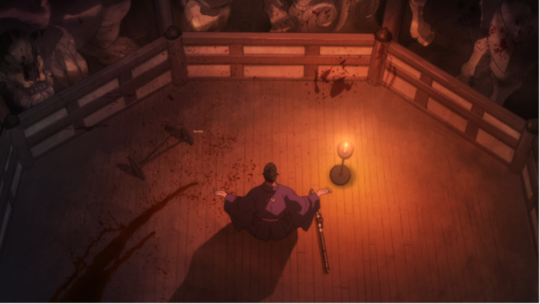
Lord Kagemitsu Daigo makes a pact with the demons (Source: Amazon)
In Anime and Its Roots in Early Japanese Monster Art scholar Zília Papp comments Mizuki’s “Kitaro characters became synonymous with yōkai in the postwar period, continuing to the present time” compared to his peers like Tezuka. But if Kitaro made yōkai big in comedic manga, then Tezuka’s short-lived Dororo manga drove this interest toward the historical context of the Sengoku Period, or the “warring states” era of feudal Japan.
Rather than depicting spirits as purely whimsical mischief-makers, Dororo’s inciting event is a feudal lord of the fictional Daigo clan forging a pact with 48 demons, who persist to hunt his son long after the pact is forged. In his feature The History Behind Osamu Tezuka’s Dororo, Marco Oliveros comments that by depicting yōkai during this period, Dororo draws inspiration from actual shifts in changing Buddhist attitudes toward these entities:
“One of the foremost examples of this change to yokai is the tengu. Wrathful and demonic, the avian creature tricked and assaulted Buddhist clerics and civilians alike, becoming characterized as the sworn enemy of Buddhism. The apparent hostility of these yokai to Buddhism makes their dark deals with Dororo's Daigo an unsurprising turn of events for the Sengoku Jidai era.”

The Amanojaku is captured and sealed inside a Buddhist temple (Source: Amazon)
Matt Alt’s 2016 translation of Japandemonium Illustrated: The Yokai Encyclopedias of Toriyama Sekien describes the tengu (mask-wearing entities usually depicted as half-man half-bird) as “deeply associated with the religion of Shugendō,” which originated during the Heian period; however they were depicted very differently in major Buddhist sects of the same era. Unlike solely “fantastical” stories of the supernatural without much acknowledgment to historical context, Dororo is interested in this context regarding capricious attitudes of spirits of people alike. Impressive malevolent entities such as kyūbi (nine-tailed foxes) also fight against Dororo’s protagonist, Hyakkimaru, typical of supernatural jidaigeki (period drama) horror stories set in feudal Japan.
However, Dororo also features lesser entities such as amanojaku (tiny, goblin-like demons). According to the influential illustrated encyclopedia Wakan Sansai Zue compiled by Sekien-predecessor Terajima Ryōan, amanojaku and tengu were described as paired descendants of the evil goddess Amanozako (literally "tengu god"). According to scholar Haruko Wakabayashi in The Seven Tengu Scrolls: Evil and the Rhetoric of Legitimacy in Medieval Japanese Buddhism, tengu were symbolically invoked in inter-personal and religious feuds amongst Buddhist sects during the Heian period. The amanojaku depicted in Dororo is minor. But with a (simplified) understanding of its affiliation with tengu’s pre-Heian origins and its subsequent disavowal by influential Buddhist sects, Dororo's amanojaku cameo is an undeniable nod toward its theme of “old ways” impacted by a "new" institutionalized status quo.

Hyakkimaru battles the nine-tailed fox spirit in its spectral form (Source: Amazon)
While the nine-tailed fox spirit is flashy, Dororo’s amanojaku ends up pathetically sealed inside a Buddhist temple. Ironically, the amanojaku trapping scene pans from the top of a Buddhist statue, ending with the cartoonish amanojaku crushed underneath to visually imply its irrelevancy. Dororo is a story about the cultural and religious tensions brewing during this violent episode in history — making Hyakkimaru’s journey one that doesn’t simply depict supernatural folkloric tradition in stasis, but as something always under complicated socio-political stakes.
Modern Ghoul School: Ghost Stories & Bakemonogatari
What do you do if you can’t solve your evil spirit problems with a sword? For the most part, classics like Kitaro and Dororo take place in the past, or at least worlds very unlike our own. A traveling demon slayer never has to deal with student council or smartphones.
In a previous article, From Bakeneko to Bakemonogatari, I discussed all the possible lineages of the catgirl character archetype. In that piece, I claimed one of the more accurate representations of the bakeneko today was Bakemonogatari’s Tsubasa Hanekawa’s cat spirit-possessed alter-ego. It’s not simply because she is a supernatural catgirl, but rather her portrayal was obviously informed by the wider context of pre-existing bakeneko mythos. Is it possible for a “modern-day” series to tackle yesterday’s folktales while still preserving the uncanniness of the past?
The spirits possessing Bakemonogatari’s cast, referred to as “oddities,” all nearly function like vengeful mononoke spirits. For example, Bakemonogatari’s first arc, Hitagi Crab, features a crab “oddity” haunting classmate Hitagi Senjougahara. The existence of heikekani (face-shaped crabs allegedly the spirits of drowned Heike warriors from the Sengoku Period), might be a parallel, considering the arc’s theme of unresolved conflict. Another arc, Suruga Monkey, features an “oddity” taking the form of a beastly paw growing on classmate Kanbaru Suruga’s arm. Senjougahara and Suruga's crab/monkey relationship can be read as alluding to the well-known Buddhist tale “The Monkey and the Crab.” According to The National Gallery of Art on its 2019 The Life of Animals in Japanese Art exhibit, the monkey and crab are usually depicted as friends, then compete until they either make amends or resolve their conflict. Often the subject of artistic interpretation, it’s no surprise this tale found its way into anime as a metaphor for teen drama.

The kids scan a talisman and e-mail it to exorcise internet demons. Yes, this really happens.
In comparison, the 2000 series Ghost Stories is best known to English-speaking audiences for being an edgy comedy. However, its original source material, a book series titled Gakkō no Kaidan (School Ghost Stories), is more akin to a heavily researched Goose Bumps. Written by folklore scholar Toru Tsunametsu, the series showcases various urban myths and monsters, most famously “Hanako” a ghost girl who haunts school bathrooms. A 2014 NPR piece describes the most popular version of Hanako being a schoolgirl in WWII “using the bathroom when a bomb fell on top of the building.” Although Hanako gained enough popularity from the books to warrant her own spin-off anime series in 1994, she only makes a handful of cameos in the 2000 series. Entities like the previously mentioned amanojaku also appear, alongside shinigami (death gods) depicted in many other anime.
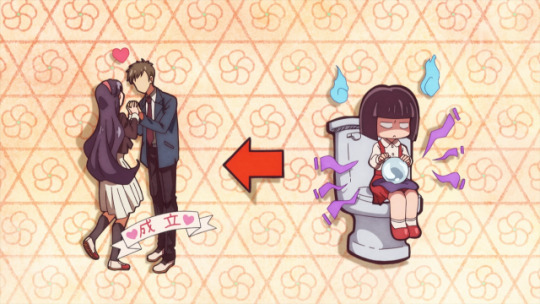
How to channel your ghost powers for success (Source: Funimation)
Hanako, because of her relatively modern backstory, is just as ubiquitous. Versions of Hanako appear in an episode of the 2018 Kitaro and most recently in the 2020 series Toilet Bound Hanako-kun. Tsunametsu currently edits the Folklore Society of Japan’s official academic journal, no doubt a testament to his priceless contributions to folklore representation in anime.
Who You Gonna Call?
There’s no way to tell the same ghost story twice. With such a layered history, contemporary anime have a nearly endless well of folkloric material to pull from. Recent series like the hit Demon Slayer: Kimetsu no Yaiba and Toilet Bound Hanako-kun prove that fans will never get enough of the supernatural, just as long as things stay fresh.
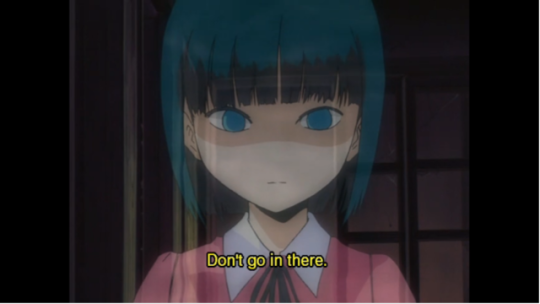
Hanako politely warns the ghost-hunting kids
Long live artistic liberty and specters trying to watch you pee.

Blake P. is a weekly columnist for Crunchyroll Features. His twitter is @_dispossessed. His bylines include Fanbyte, VRV, Unwinnable, and more. He'd like a tiny yōkai cat.
Do you love writing? Do you love anime? If you have an idea for a features story, pitch it to Crunchyroll Features!
By: Blake Planty
25 notes
·
View notes
Text
━ i. what you broke

pairing: tobio kageyama x f!reader
genre: enemies to lovers, royal!au, angst
summary: prince tobio kageyama is cruel. he was known to be vindictive, revengeful, other synonyms for anger’s embodiment. you were not quite as interesting: a simple village girl with a knack for stealing things and will to kill the prince.
a/n: my first published fic on this account! i do hope you enjoy~~
tags: angst, royalty, swearing, medieval, fantasy, enemies to lovers, all characters are aged up, minor depictions of violence and death (no major character death)
glossary
next chapter

There was little to no effort as you weeded you way through the crowded streets. Though the sun shone brightly in the sky, you were nearly invisible. You needn’t a distraction as your hands skimmed the villager’s pockets and bags. You needn’t a disguise as you pocketed a fine gem from a shopping lady.
Not when you were in good relations with the general’s family.
You quickly swept through the streets and into a more quiet part of the town. The part you most disliked. There was not enough sound there, not enough places to run your hands through.
Still, it was home nonetheless.
You crouched to a stray cat and handed it a small cup of milk you had managed to obtain.
“I can’t stay long, kitty.” You whispered to it as if it could hear you. As if it understood.
The town square now behind you, you were walking towards the castle. You were not going to the actual castle, although the thought of stealing from them is incredibly tempting in a way only your mind could fathom. You were walking to a nice series of houses a little further down the hill from that.
The Castle of Kageyama sat perfectly structured on the top of a large hill. Nearly a mountain, but you were hesitant to call it as such. With towers of varying heights casted around it, the castle was almost as terrifyingly dark as the prince inside.
Below the castle were the High Order. The general and his family, knights and theirs. Cooks, messengers. Those in favor of the castle and those who work for them.
And below that, the villages in which they rule. Dusted in browns and poverty, surrounded by lakes no one dares swim in lest they be drowned by sirens. Guarded by goblins and ogres and soldiers alike.
They were kind if you were to them.
You were not fond of the prince. If you were being blatantly honest, you hated the man. He had no honor.
You watched as he clipped the ears of an elf who dared not bow to him. You watched as he called the city you lived in, the city he were soon to rule, filth. You watched from afar as he pointed his sword at your sister’s neck for your father’s disappearance.
And you watched as he killed her.
One day, it would be your blade at his neck.

The creaking of the door was the only sound that gave away your presence. The general peaked from the kitchen, bowl of something delicious in hand.
“I imagine I do not wish to inquire what you have been doing?” The general asked you after you closed the door.
“You would only be delighted.” You joked. “And where is Kiyoko?”
“She’s in her room. She was at a ball this evening, so I believe she’s changing.”
“Thank you, sir.”
The general was a kind man. He welcomed you whenever you arrived, happy to allow you to eat with them in the Shimizu house. In the beginning, he was hesitant to let a foreign village girl into his home. But your friendship with his daughter quickly let him forget about that.
Kiyoko was beautiful. She was two years older than you, dark hair and bright eyes that shined beneath lenses. And one single mole under her lip. You could only imagine how many men danced with her at the ball. Women, too.
“What did you sneak this time?” She asked as soon as you entered her bedroom.
She was slipping out of a gorgeous blue dress. You paid that no mind, sitting on the edge of her bed in your (rather dirty) black cloak.
“Look!” You fanned out your items of the day.
An antique fan, a shoelace with a rubber nub at the end, varying food, a small bracelet made of braided rope, and the blue gem.
“All of this from walking from your house to mine?” She raised a brow. You nodded.
Her eyes immediately lightened at the gemstone. “That’s a sapphire! You could sell this to Tanaka and Nishinoya for an incredible amount of money.”
“I figured it would be much, but how much?”
“At least... at least a moonful.”
“You’re lying.”
“I don’t lie. You know that.”
You were grinning ear to ear. One single gemstone may be cause of your fortune. You could apply to be a knight in the high order with a moonful.
“Put it away.” Kiyoko hushed, placing the gem into your palm. “I will phone the boys and see when they can meet. You’ll be a great knight.”
She pressed a kiss to your cheek and headed for the stairs. You followed suit, adjusting the sword that hung at your hip under the cloak.

The first time you had picked up a sword was when you were three years of age. You were a tiny thing, smaller than most and malnourished from your father’s lack of... well, everything.
You were running through the streets, playing with your older sister. Her long hair passed behind her, your three year old legs having trouble keeping up with her six year old ones.
But everything stopped when your eye caught on a sword on display at a shop.
The blade was made of pure silver, the handle carved into false blue vines that twisted into the actual blade itself. It was beautiful.
The vendor noticed your childlike wonder and smiled down at you. He came around the side of the table, picking up the blade.
“Do you wish to hold it, little one?” He offered.
You nodded instantly. You hadn’t even noticed your sister’s return to your side, watching your infatuation with the object.
The second the sword touched your palms, you wanted to swing it. You wanted one your size. Your toddler arms could barely hold it up despite you holding it in both arms bridal style.
“I may have one your size.” He winked.
The man went behind the counter only to return with a small wooden one with a dull blade. It was not nearly as beautiful, but you could hold that one.
“How much for it?” Your sister asked, looking through her pockets for any money she may carry.
“Worry not.” The vendor placed the blue and silver one back to his stand, and then proceeding to crouch in front of you. “You can leave with that one.”
Your sister thanked him, bowing and asking again if it were really all correct if you took it. But you were already swinging the thing around, the air around you feeling lighter and a smile on your three year old face.

“I don’t see why I must go wonder the village.” Tobio Kageyama argued. “Why must I go walk a place where I rule? This is why we have advisors.”
“You will be crowned in a month’s time, Tobio.” The king spoke. His voice was loud, booming. It commanded respect to any who hears.
The king had the adoration of most of his kingdom. He was worried for his son, who already had a reputation of irritability and anger. He knew that he would be all correct, all kings had a different way of gaining respect.
“And tell me why we cannot crown Miwa instead?”
“Because she is overseas. Because she is studying and to marry the sea king.” His father rubbed the space between his brow. “We have been over this many times, Tobio. No matter your rebellions, you will be crowned.”
“May I take a friend, then, if I must trudge through the grime?”
“Fine.” He huffed. “Watch your words. This grime will be your kingdom soon.”
“Yeah, whatever.”
“You will be kind to be careful of your tongue if you wish to keep it.”
“Yes, father.” Kageyama corrected through bared teeth. He turned to the nearest servant. A human standing at the entrance to the hall. “Call for Shoyo Hinata. Tell him to make haste, we’re going on an adventure.”

The sun was setting against the horizon. Some days, you wished that you could see it; watch the sun set over a line of a horizon. But the sun always disappeared beneath the forest’s trees that circle the town.
You imagined that the castle had the perfect view.
Kiyoko and you had dueled for a while before you left. Being the daughter of the general, she was skilled with a sword. Though she was better with daggers, she still gave you quite a fight.
Near the end, you both were sweating. You had almost managed to overtake her.
“Good job. Soon you’ll be better than I.”
“That is incredibly doubtful, you’ve been doing this since you were born.”
She only smiled, saying, “There is a difference, though. I was born without talent and taught to battle, trained to be this way. You were born with talent and continue to train that talent. One day, you will best me. I can bet on it.”
You were still thinking of her words as you walked through the brown paths home. Most people were doing the last of their daily shopping, reading to head home before the ghosts come out.
Kiyoko had given you a little bit of money, telling you, “For on your way home. You won’t be suspicious if you buy things on occasion.”
She was correct, of course.
You stopped to get cheese and bread. You had some fruit still in your pockets, but food was better warm.
You thanked the vendor. You plastered your best fake smile to them, bowing your head a little in respect.
You hated common courtesies.
You caught a glimpse of a bracelet on a woman who was looking at a basket shop a couple of yards from you. You could leave it, return to your mission home.
Your hands tingled in anticipation. You could not help yourself.
Before anyone could see, before anyone had the chance to even acknowledge your position at the shop, you had the bracelet unclasped and in your palm.
You truly had to give yourself the credit for your talent.
Perhaps it was the fear of never stealing again once you enter in the knight program. Perhaps it was the adrenaline you never fail to feel when you snatch something in plain sight. No matter; you could not help but smile to yourself.
That is why your heart seized in it’s chest when you found yourself face to face with the prince.

“I do not see why you are not enjoying yourself more, Tobio.” Hinata spoke. He rode his horse a little behind Kageyama. Kageyama figured it was out of respect, but Hinata just had a slower horse.
Hinata’s orange hair was nearly glowing. It could be from his powers, but he was sure it was from the setting sun.
“I do not wish to prance through poverty.” Kageyama told him. “Why must I get my hands dirty when we are not supposed to leave the castle for prolonged periods?”
“You get to meet people.” Hinata smiled, looking ahead. They were close enough that he did not have to use formalities, honorifics. “Don’t you wish to see what the people are doing in the place you rule?”
Scoffing, Kageyama dismounted his horse. Hinata followed suit.
It was ridiculously symbolistic, their horses. Kageyama’s was a slick black, donned in dark metal armor and piercing eyes. Much like himself. Hinata’s horse was palomino, light with white hair and white saddle and an almost smile.
They walked beside their horses as they entered the town. Almost instantly, they could feel the atmosphere change. Whispers ignited through the people. As they walked by, each one bowed in honor.
Except you.
You were too busy looking at something in your hand, eyes agleam in something Kageyama could only claim as mischief.
He had viewed the same look in his own mirror.
When you looked up, you caught his eye. You didn’t bow, you didn’t even mutter an apology.
No common person had ever looked him directly in the eye before.
“Where is your respect?” Tobio Kageyama asked you. His voice was deep, dark. A warning.
You had to hold back a roll of your eyes. “Not with you, my lord.”

masterlist
#anime#manga#haikyuu#haikyuu x reader#haikyuu x you#haikyuu one shot#haikyuu one shots#haikyuu imagine#haikyuu imagines#haikyuu au#haikyuu headcanons#haikyuu hcs#tobio kageyama#tobio kageyama x reader#tobio kageyama x you#tobio scenarios#tobio x y/n#tobio headcanons#kageyama#kageyama x reader#kageyama x you#kageyama x y/n#misha🦋writes
114 notes
·
View notes
Text

🍙Welcome to Tohru Honda’s tumblr!🍙
This blog contains Fruits Basket edits by myself @lunastellanova , reblogs of Fruits Basket information/art/fanfiction ect, and will eventually include meta from the perspective of Tohru Honda. She and I think very alike and have gone through many of the same things. We are both year of the Dog, and ENFJs.
Note: this blog will NOT be spoiler free. Image sets with spoilers will be tagged with "fruits basket spoilers" and major spoilers will include "⚠️ SPOILERS ⚠️" in the post.
🐱🐭 🍙 🐶🐍 🍙 🐮🐴 🍙 🐯🐏 🍙🐰🐗 🍙 🐉🐓 🍙 🐵
Navigation
🍙 About Tohru Honda & About the Author - All about Tohru and how i relate to her enough to write from her perspective. (coming soon)
🍙 Why to watch Fruits Basket here
🍙 Fruits Basket anime rankings here
🍙 When was Tohru born here
🍙 Tohru's Diary - Episode meta analysis by Tohru (coming soon)
🍙 Tohru's Friends- Character analysis (coming soon)
Best Friends & Family: Kyoko (Mom!) | Arisa Uotani | Saki & Megumi Hanajima
The Sohmas: Yuki | Kyo | Hatsuharu (Haru) | Isuzu (Rin) | Momiji | Kisa | Hiro | Kagura | Ritsu | Shigure | Hatori | Ayame | Kureno | Akito | Kazuma (Shisho) | Ren & Akira
School Mates: Machi Kuragi | Kakeru Manabe
🍙 Tohru's Calendar - Episode lists
First Season here
Second Season here
Final Season here
Feel free to DM me or send me an ask if you're interested in discussion or chatting.
🐱🐭 🍙 🐶🐍 🍙 🐮🐴 🍙 🐯🐏 🍙🐰🐗 🍙 🐉🐓 🍙 🐵



My Other Blogs
Luna’s La La Land - 18+ minors DNI
This is my primary blog which includes multifandom anime, my photosets and edits, fanfiction and some other general posts.
Bishonen Fantasies - 18+ minors DNI
My photosets and gifs, images and fanfiction/smut of sexy anime guys.
Flames of Passion K Project Fanfiction - 18+ minors DNI
Mikoto Suoh x OC fanfiction, original story art, and other general Mikoto Suoh and Homra posts.
#fruits basket 2019#fruits basket#furuba#tohru honda#fruits basket meta#fruits basket anime#top anime#best anime#shoujo anime#slice of life anime#comedy anime#tragedy anime#fruits basket the final#fruits basket season 3#fruits basket season 2#fruits basket second season#fruits basket third season#fruits basket first season#fruits basket season 1#fruits basket 1st season#fruits basket 2nd season#fruits basket 3rd season
39 notes
·
View notes
Note
You might've answered this already and I just didn't find it, but one thing that always perplexed me about Duke was how old he was in comparison to the other Batkids. It's obvious he's younger than Dick and Babs, and I pretty sure he's younger than Jason and Cass, and older than Damian, but I cannot tell if he's meant to be Tim and Steph's ages, younger, or older. Could you help me?
You’re all kinds of good here, anon!!! I answered a similar ask abt the Order of Adoption but didn’t dive into specific ages on that post BECAUSE well they didn’t ask lmaooo but ALSO:
Comic ages are very fluid usually! While Years™️ might pass in the canon proper, or while time seems to slow to a crawl, having a character’s age outright stated is something that occurs very rarely for most characters, if at all!
Because it’s always much easier to have a floating age range to work and play around in! It’s easier to keep a character Perpetually 12 or 16 or 25 or mid-40s or- you get the idea. SO, with that in mind. Let’s do our Best to Break Down What Age Duke Might Be Currently A N D how it might interact with the Other Batkids!
(Warning for a Very Long Post, lots of issue citations, and a LOT of comics terminology regarding specific runs/events/continunity. I’m gonna try to keep it as clear/concise as possible ofc but plz keep these things in mind! If you’re not at least marginally familiar with Bat-Comics, you might find yourself feeling a little lost here!)
So from the Zero Year arc we see a common Trend that plays out pretty consistently with Batfam comics: a Life-Changing Event Occuring while the protag is Young™️.
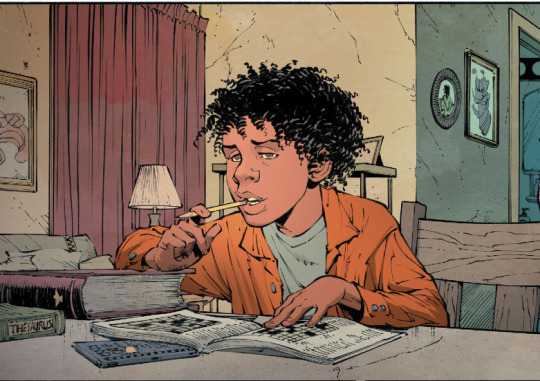
(Batman (2011) #30)
With how Duke is drawn in these particular issues, and given the trends of the past, I’d place him in the 8-12 range. The historic precedent being ofc that that is the same range that canon usually places both Bruce and Dick at for their Tragedies™; the more benign reason being that he... just very much Looks to be drawn in that Range. He’s very clearly an Older/Prepubescent child here.
Fast Forward to his Next Appearance in the Endgame arc and-
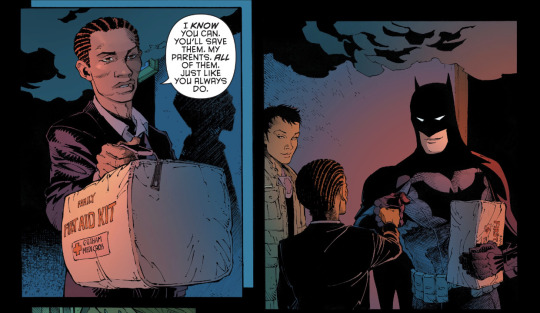
(Batman (2011) #37)
He’s definitely older! He’s wiser! And he’s giving Batman a fistbump lmao. Again, no strict age given here BUT, since they condensed each Robin to a Year or Two tops with Bruce (its n52 and its fucked up is what it is), we can assume it’s been at least 4-5 since Zero Year (which would mean if we go off the age range I proposed for that year, then theoretically he could be anywhere from 12-16 here, and I think that tracks pretty well. Not Perfectly and Certainly Not so well with Pre52 continuity ofc, but I’ll talk about that later!)
In We Are Robin, while its not stated Directly In The Text, it IS given as an Informational Tidbit that Duke is 16 (specifically this can be found at the end of issue #4)! (Sweet sweet canon confirmation FINALLY)
We know that WAR takes place Fairly Soon after Endgame (almost immediately, give or take a month or two given that Duke’s been placed in a few foster homes at this point and has racked up Quite A File) now, again id like to remind y’all that while this is a NICE starting point to have, keep in mind that comics are fluid and this may be retconned slightly/ignored in later stories bc Keeping Duke 16-ish is in DC’s Best Interest at the moment. (Having Relatable Teen Characters afterall is a Good Marketing strategy™️. And the longer they can Keep them Young, the Better)
With that in mind let’s take a moment to Highlight the fact that Duke and Damian have crossed paths at this point AND the storylines that have occurred during this year that were meant to be in conjunction with one another!
Because Prior to Endgame, Damian had Died! And just a year (in real, meat-space time) before We Are Robin, he was resurrected and had begun his “Year of Atonement” in the Robin: Son of Batman maxiseries. Midway through both this series and WAR (and, we can assume, midway thru this “Year” for Damian) the Robin War begins/ends and we see at least one major Moment between these two boys who will soon call one another brothers:

(Robin War #2)
Given that R:SoB is followed up VERY quickly by Teen Titans Rebirth (in which Damian celebrates his 13th birthday), we can conclude that Damian would be 12 during this time (well, 12 and 1/2 to play it safe lmao). That being said, this Confirms about a 4yr gap between Duke and Damian! (One Batkid down at least! but he’s the key to the others so put a pin in him!)
As We Are Robin draws to its conclusion, DC was releasing another arc that would eventually flow into the Rebirth Era, by the end of which, Bruce would approach Duke with an Idea (which involves Bruce becoming Dukes temporary guardian & as he states Many Times “Trying Something New” with Duke).
And thus the Rebirth Era begins, and Duke began his Year of training (most directly encapsulated by the Cursed Wheel arc in the All-Star Batman run:
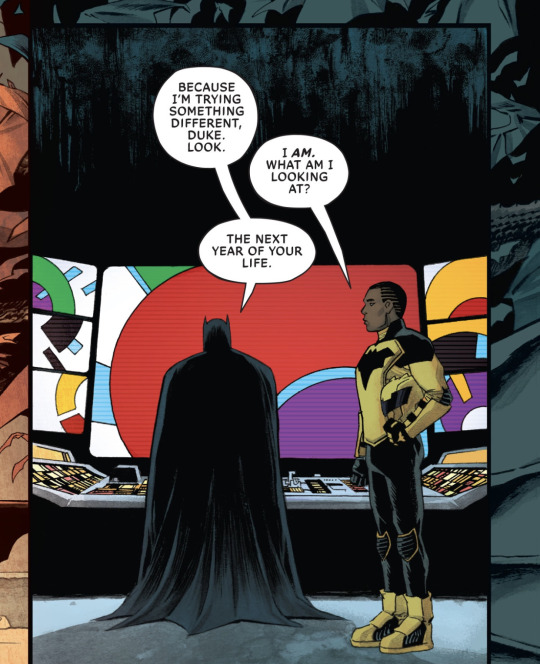
(All-Star Batman #1 (back-up story))
Bruce introduces Duke to a training regimen that Alfred has named “the Cursed Wheel”. It encompasses all the training Bruce and the other bats have undergone and condenses it down into color-coordinated segments that will take Duke a Year to Complete.
It can be assumed that by the End of this Year Duke will somehow miraculously still be 16, despite, again, an entire ass year passing.
There’s one story that takes place mid-year in All-Star Batman, and the Cursed Wheel is meant to be capped off by Duke’s first Official Day as the Signal (in the titular Batman & the Signal ofc) BUT, near as I can tell after this story, Dukes age is not brought up again. So until they DO bring it up either in Batman & the Outsiders or whatever future run Duke becomes involved in, we can assume DC will be working with the idea that he’s meant to be in that 16-18 range from here on out (ie still a minor).
But, dear anon, you might be saying “okay, that’s cool, but how does that relate to my question abt how he falls in with the other Bats?” You’ll have to be a little patient with me here, but I think I may have cracked the code!
Keep in mind I’m gonna be addressing both the Post-Crisis to Flashpoint Continuity (ie mid-80s to 2010 in comics history) and the N52-slash-Rebirth Era (2010-Today). Its generally agreed by fandom and DC alike that these points of rebooting &/or Major Events constitute the era of “Modern” comics, and that everything from the 80s-on might more or less be canon on some level, even if not All of it is.
(Plus, most of fandom usually likes to borrow elements from both eras and much more rarely from stories before it, SO-)
Lets do a quick rundown of how everyone who’s Closer to Duke’s Age, Relates to each other first, age-wise:
Given that Jason was 15 when he died, in A Lonely Place of Dying its established that Bruce had become increasingly reckless since his death, and by the end of the story, Tim has stepped in to fill Robin’s shoes (he states that he’s 13 during this story btw). Pretty soon after, Stephanie Brown is introduced & established to be about a year older than Tim (wish I could pin-point a specific issue BUT, i unfortunately haven’t read any Tim OR Steph-involved comics that predate No Man’s Land... Besides the aforementioned Lonely Place and Young Justice technically, but im working on remedying that soon!)
NOW, during the No Man’s Land event, Cassandra is introduced, and pretty soon into her Batgirl run, its revealed that she’s around the same age as Jason (or at least how old he Would Have Been, had he not died.) Now, given that Jay has an August bday and Cass has a January one, fandom sometimes likes to play around with the idea of one being older than the other (OR even speculating/placing them in an AU as twins/siblings, given that Lady Shiva (Cass’ mom) was a Possible Candidate to be Jason’s biological mother but that’s a Whole Other Thing i wont get into here.)
The point being, Cass, in this era of comics, IS slightly older than Tim and Steph. At Tim’s start as Robin, their ages could either line up like: Tim-13, Steph-14, Cass-15 (being a few months ‘behind’ Jay), then Jason at 15/16 (depending on how soon Tim filled the role after Jay died in April) OR Jason-15/16, Cass-16/17 (in this case she’d be a few months ‘ahead’ now instead)
So brief detour to talk New 52, however! Because Tim, Steph & Cass all got switched around from where DC originally left them prior to the reboot! Now I haven’t read much of them in this era, other than Batman & Robin: Eternal, so my Understanding of their current ages is Spotty at Best. The general consensus seems to be that while before N52, Stephanie had been attending her first year of College (& doing VERY WELL i might add), with the reboot she was set back a few years alongside Tim to a vague Late-Teen state (so 16-18-ish, instead of a Very Clearly Established 18/19). Cass is probably the worst off for this reboot, given that B&R:E basically constitutes her new origin for the new continuity, and does nothing to confirm her age (all I really know is that she’s a Vague Late-Teen too... Probably? Maybe?), given how much they infantilize her, and subsequently how fandom in turn has taken to infantilizing her too, theres a semi-popular fanon that places her Younger that Tim and Steph. And I, for one, propose that we ignore that bc its Weak Sauce my dudes.
Some fans chose to ignore N52 continuity due to this vagueness, and will stick to the ages established before the N52/Rebirth reboots. But its something to keep in mind regardless bc we’re all obviously going to pull from what’s most familiar to us!
But WHERE could we place Duke with regards to them, then? Because them being “Late Teens” is certainly much too vague to work with!
This is Where Damian is the key!
Because Damian is one of those rare exceptions to the Reboot Rule. His story flowed almost seamlessly over from before to after. While he was made a Robin at the age of 10, he continued to grow and learn even after the universe was being rewritten to suit the whims of DC editorial.
If we choose to ignore how everyone else’s ages and origins were swapped around, and stick with the growth that was presented before the reboot, then we can draw some interesting conclusions!
Firstly, though Stephanie also had Died and subsequently Returned, she hadn’t lost much, if any time, from the Ordeal. At the start of her Batgirl run, she is enrolled at a Gotham university and making headway with a more firm foot in the Batfamily (even to the point that she and Damian spend a few issues bonding. At this point in time, Damian is definitely 11, and again, Steph can be assumed to be 18/19 during the course of her run. We’ll assume 18 for clarity’s sake.)
So, then when Damian is 11, now our line up is as Follows:
Dami - 11, Steph - 18, Tim - 17, Cass 19-21 (the range depending again, if you subscribe to Cass being either older/younger than Jason).
WHICH MEANS, If during Robin War Damian is 12 (and a half) THEN We’ve got an age line-up that Potentially looks Like This:
Dami -12(and 1/2), Duke - 16, Tim - 18, Steph - 19, Cass - 20-22 (And Obvsly Jason, Babs & Dick at their varying Older Ages than everyone here)
and im just now realizing i Didnt include Harper in this line-up, but thats bc she’d also throw a big wrench in all this. I’d personally throw her in with being Steph’s age, but I’m pretty sure she was supposed to be either that, or between Steph and Cass (again, since its N52, i believe Cass was/is assumed to be Younger than Steph, but that contradicts the assumed following of pre52 canon that we have for the above line-up, obvsly, and so we ignore that lmao)
All this to say, however, that canon and fandom is what you make of it, and if you want to wiggle these ages around a little, you’re more than allowed! God Knows i usually like to skew the Tim-Steph-Cass age group to be a tad older than this in my own fic writing, and I like to have Duke start as a Robin at 14/15 instead of 16, but that’s just bc I like the dynamic potential it could bring with them being Definitively Older that him, and thus in a more secure place to be Mentoring him right alongside Bruce & the others.
But you might see these age ranges and want to do something Different (say, making Tim, Steph, Cass, & Duke all the Same Age at 17 instead! And that very well tracks with how current comics kinda looks right now!) and you’re absolutely valid to do so! Because again, comic character’s ages are meant to be fluid, not fixed!
And at the end of the day, its all about wanting to see these teen heroes kick serious ass haha
#duke thomas#guest starring:#batfamily#damian wayne#tim drake#stephanie brown#cassandra cain#randywrites#randys meta#meta#asked and answered#anonymous asks#this was A LOT and i tried to throw some humor where i could#but uhhhh yeah!!! i hope this helps anon!!!#also just realizing its TWO AM WHERE DID THE TIME GO#ah well. Worth It
108 notes
·
View notes
Text
Actual thoughts on the Icebrood finale below the cut, proceed at your own caution.
I don't really have any issues with what happened in the finale, and the whole instance was incredibly cinematic. The short but rad kaiju fight? Ryland's death and Rytlock's + Crecia's grief? Braham being distinctly not dead? :chef kiss: And considering the nature of Champions as filler content, we got about what I expected.
That said, the whole damn thing was just too fast and suffered from devs being forced to cram in this story with limited resources + time. I like the idea of elder dragons being pulled to leylines, Aurene getting to be a prism, etc, however I feel like these are major story beats that should've been slipped in earlier in Champions.
Have Taimi or Gorrik drop some lines through the earlier DRMs about the possibility, make a bigger and earlier deal about having to manipulate Jormag into a fight, etc. so the finale doesn't have to bear quite so much. If Jormag's the dragon of Persuasion, we should have our work cut out for us to get them where we want them. (And please, please have the gameplay reflect the gravity of the finale a little better. It doesn't have to be that super mechanically challenging, but we should be doing something more than pressing our special action key. That's a little hyperbolic, but I'm just thinking about this in comparison to the Mordremoth + Kralkatorrik fights).
Related, I feel bad for asura players and dwarf enthusiasts about the lack of general involvement Primordus had when all's said and done. Not that a dragon whose defining character is 'mindless rage' needs to have more personality, but I feel like the defense-event style DRMs weren't quite enough for us to appreciate his impact. (On that same note, I wish Jormag had more to say in the final instance.)
With the big rocky boy gone, the chances of getting to see the Depths, updates on Asura society, etc. slip further and further away. The same can be said for all the charr and norn development that got dangled at the beginning of IBS, but at least they got a couple of full episodes dedicated to them (well, moreso charr than norn. Sorry norn mains).
Speaking of which...I'm 100% biased because I mostly play charr, but I was so excited for all the core Tyrian story threads that now might never see full closure. Will there be follow up on the whole Khan-Ur situation? Is the Foefire there for good? And what of the minor story beats introduced in IBS? What about that likely Inquest agent in Grothmar interested in Aurene? The lasting impact to norn society of what actually went down with Asgeir and the fang?
Regarding the whole 'killing more elder dragons with little consequence' thing, that'll be probably be a separate post. I feel like a lot of the commenters I'm seeing on reddit and wherever may've not seen the dialogue from Aurene mentioning that most of the magic didn't get absorbed. Maybe she really is capable of containing it, but I don't think we're skipping over that disruption to the All.
I've also hardly talked about character stuff here, but I'm curious what/if any character development Braham will have now that his major arc is complete. Will he get to tag along with us in EoD? (On the other hand, I feel like Rytlock's going to be sidelined a bit after this. He's got a lot to work through).
Also I know I joked about Bangar being a puddle earlier, but it'll be interesting to keep him around. Not that I'm expecting/hoping for a redemption arc, but like with Braham, I wonder what Anet has planned for the character. Plus it's Graham McTavish, come on.
Lots of negativity, but I think it's mostly because I'm saddened about the potential IBS had that got squandered. I feel even worse though for the devs who had to cut their plans short. That said, I'm not any less excited for what's coming ahead (hellloooo armory and more legendaries), and I still appreciate all the parts of IBS I initially enjoyed! Grothmar to this day is still one of my favorite maps and story steps.
I'm getting the impression a lot of people, players and devs alike, are ready to move on. I'll be curious to see how people feel about it a few months from now and further on down the road.
One last note, I'm replaying through all of IBS from the start rn, and I want to see how all of Champions feels as the one big episode that it is. Will probably have more input then!
#gw2#gw2 spoilers#ibs spoilers#icebrood saga spoilers#icebrood saga champions spoilers#i try to be nothing if thorough with my spoiler tags#also this got long whoops
15 notes
·
View notes
Note
Hello Laura,
I’m 98% sure I’m accidentally going to end up rambling with this and also this may seem like a outta left field ask so... fair warning and I’m sorry in advance if it comes off as ‘huh?’ or something like that.
I’ve been out of the loop for a few days now and just logged on to see the Constellations Ask Game.
Personally, I love love LOVE comparing different methods like
horoscopes
zodiac
astrology/constellations
birth signs
cartomancy (probably one of my favs - I find this one really interesting)
tarot cards (both different and similar to cartomancy and vice versa... but, my opinion, these 2 methods are more different than they are similar)
palmistry
numerology
pendulums
spirit animals
and other fortune/horoscope telling methods/tools from all over the world through history. Practices like these and others alike that are scattered through history can seem small and insignificant in the grand scheme of things with everything that’s happened throughout the centuries...
but things like this, knowing the symbolism of something can give you a better insight of understanding different religions, mythologies, demonology, art, cinema, literature, etc. etc. because at the end of the day, when there isn’t much to go on, how symbolism is interpreted by someone and then used in whatever belief or work; based off of said interpretation can lead you to draw allegories between works, beliefs, or societies you probably would’ve never thought could’ve gotten something from one another; regardless if it was conscientiously or not - symbolism can open the doors to questions like
Why did this culture choose this to represent that?
Were they an isolated society that made it up on their own or could they have learned it from someone/somewhere else?
What was the interpretation then and the connection to how it is viewed today?
What allegorical conclusions can be drawn between this method ‘originated’ at point a and that method ‘originated’ at point b - if these two cultures are on opposite sides of the world and had to foreseeable means of communication with each other?
Etc. Etc.
& That’s one of my favorite aspects about Black Clover other than the story itself and the captain/magic-knight eye candy: Tabata’s use of symbolism and mythology is a talent in of itself; the way he dissects the tiniest context of something from various European mythologies and then uses it to his full advantage to hide in the crevices of a character, continually builds upon each reference and said reference(s) will start to reveal itself(themselves) as the character(a) develops throughout the progression of the story... sorry that was a bit of a tangent - but Tabata’s use of these things throughout Black Clover is so ingenious he deserves recognition and praise for that aspect of his storytelling...
I’m rambling aren’t I? (i warned you at the beginning this wasn’t going to be a conventional ask, sorry if I keep getting off topic) SO THE POINT OF THIS ASK — THE CONSTELLATIONS ASK GAME – I already knew there was a whole plethora of constellations named after figures in Greek mythology... however I was only briefly aware of a handful of Greek Mythology constellations that were used in astrology personality/horoscope predictions like our typical western Aries/Taurus/Gemini/Cancer/Leo(plod)/Virgo/Libra/Scorpius/Sagittarius/Capricornus/Aquarius/Pisces.
Dang it! I was rambling again wasn’t I? Stop rambling me! MY POINT IS: this ask game is one of the first times I’ve seen this many Greek Mythology constellations used that are apparently also used similarly to western zodiac astrology/horoscopes...
SO Laura, I was just wondering if you could please tell me if you knew the name or branch where these constellations stem from - in terms of fortune telling and birth signs? or just any knowledge basically you have in general related to the following?
Andromeda
Cassiopeia
Corvus
Draco
Hydra
Lyra
Persei
Pyxis
(tbh, going down the list, with all the Greek mythology references I almost asked about Taurus too because I read it as ‘Tartarus’ 😅)
Ursa Major
Ursa Minor
Apus
Aquila
Caelum
Canis Major
Crux
Indus
Lupus
Musca
Orion
Pavo
Phoenix
Puppis
Laura, if this is all too odd of an ask I completely understand... and again I apologize for how overboard I can get with my rambling... I just get very passionate and excited so when you’re trying to type it all down vs. talking to someone face to face where it’s easier to read social cues... it’s more difficult remembering when to cut off the sentence and shut up... like now🤭
Always, always, always enjoy your blog Laura! Regardless if this gets answered or not - I hope you have a lovely rest of your day!
Hiya anon~! ^_^
No worries, no worries, we all can ramble when we get exited!
But let me, let me try to get a hold of this first 😅
Okay, so:
I am not that well versed in mythology, but I do have a kind of fondness for it.
Andromeda & Cassiopeia: I believe that she was a princess in Greek mythology, the daughter of Cassiopeia. And the story goes that Cassiopeia boasted about being the most beautiful, which angers Poseidon. And Poseidon then sends a kind of sea monster (or a dragon) to torment the nation.
Andromeda is to be sacrificed for the beast in an effort to calm it, but she gets saved Perseus (who later marries her and makes her his queen). And "Andromeda" apparently means "Ruler of men".
I don't know if the name "Cassiopeia" means anything, but it seems to be connected to beauty.
Corvus: It's a constellation that was known as "Raven" in some point, and was apparently one of the constellations that marked the Gates of the Underworld. So, an omen of death.
Hydra: Hydra was also another constellation to mark the Gate to the Underworld, and a general symbol/omen for death. Of course, there's the Hydra that Heracles defeated as his 12 heroic acts.
Draco: I might be mistaken, but I believe that Draco might be another name for Hyra. (If anyone knows better, please do correct me)
Persei: Is a triple star system, that I suspect is referring to Perseus. (Or named after Perseus)
Pyxis: I have no clue.
Okay, I'll... I'll answer on the longer list of constellations a bit later (because I need to wrap my brain around it). But I thought that I'd give a little something already now so that I don't keep you hanging 😅
And in the meantime, I do hope that you have a great day as well! ^_^
8 notes
·
View notes
Text
writing secondary characters
source: https://www.masterclass.com/articles/how-to-write-supporting-characters#what-are-supporting-characters
What Are Supporting Characters?
A supporting character is a person who plays a role in the life of a story’s protagonist. Novelists and screenwriters don’t anchor a story around supporting characters, but they use them in the process of worldbuilding to create a compelling backdrop to the main character’s story arc.
A well-written supporting character will have a character arc, a strong point of view, and clear personality traits. In many cases they will be the types of characters a reader might recognize from their own life and—like main characters—they will grow and change over the course of the storyline. Characters who don’t change are known as flat characters, and while certain bit parts work just fine as flat characters, the majority of your secondary parts must be dynamic and engaging to a reader or viewer.
Margaret Atwood’s 7 Tips for Writing Supporting Characters
Your secondary characters are formed by their life experiences. Character and event are inseparable because a person is what happens to them. This is true for main characters and minor characters alike. Even if a secondary character only appears sporadically throughout your novel, short story, or screenplay, supporting characters exist insofar as they experience events.
Secondary characters must be three dimensional, just like main characters. Your job as a writer is to learn about your character by observing how they interact with the world around them. Characters—like real people in real life—have hobbies, pets, histories, ruminations, quirks, and obsessions. They also have a backstory, just like the protagonist does. It’s essential to your novel that you understand these aspects of your character so that you are equipped to understand how they may react under the pressures of events they encounter.
Keep a track of your secondary characters with a character chart. When Margaret writes, she makes a character chart on which she writes each character, their birthday, and world events that might be relevant to them. In this way, she keeps track of how old characters are in relation to one another, and also how old they are when certain fictional or historical events occurred.
Make your characters interesting. Characters, like people, are imperfect. They don’t need to be likable, but they must be interesting. For example, Moby-Dick’s Captain Ahab was certainly not likable, but he was compelling, and that is Margaret’s bar for writing characters. Sometimes the characters in supporting roles are the ones who are easiest to push boundaries with. You should aim to create an interesting character that directly abets or stymies the protagonist’s goal but in a way that doesn’t necessarily conform to a worn-out archetype.
Every character needs to speak with purpose. When your characters are speaking, they should be trying to get something from one another or make a power play. As you draft each scene, ask yourself what your characters are trying to get. What are they trying to avoid? How do these wants inflect their speech and guide what they say—or don’t say? As you compose dialogue for your supporting characters, be mindful of their character roles within your primary storyline (as well as any subplots). Use their conversations efficiently to contribute to worldbuilding, character development, and the escalation of plot.
Take time to get dialogue right. To get dialogue right, you must understand how your characters speak. This is likely influenced by where they come from, their social class, upbringing, and myriad other factors. Speech and tone are always bound up in what has happened and is happening to a character. Shakespeare was exceptionally deft at encoding his characters’ speech with these social markers. In your own story, if the lead character is from Colorado and his best friend is from New York, their dialogue shouldn’t sound the same. Just as their worldview and personality traits must be distinct, so too must be their way of speaking. Most first-time authors tend to get their major characters’ dialogue correct, but it’s supporting characters’ dialogue that can separate great authors from those who are merely decent.
Choose secondary character names wisely. Be sure names are distinct, Margaret cautions, so that readers can tell characters apart. In cinema, the original Star Wars trilogy does a great job of this. Assuming Luke Skywalker is the protagonist, supporting character names like Leia, Han Solo, Chewbacca, and Obi-Wan Kenobi are all distinct from one another, which aids a first-time viewer who is new to the Jedi universe.
#writing#writing tips#masterclass#Author#instagram#just writer problems#writers on tumblr#writers of ao3#writerscorner#writeblogging
13 notes
·
View notes
Text
okay so i finished love, victor a while ago and i saw some other reviews and thoughts about it here so now i've got a pretty good list on my thoughts and feelings.
tl;dr: it has some issues, yes, but im gonna hold out and hope it gets better later on because the same thing happened with the first few eps, i wasn't that into it but then it got good, and nothing is ever great with the first season, because at that point we're getting used to those characters.
⚠️caution: spoilers ahead (im on mobile, i cant get an under-the-cut)⚠️
1. while a leah on the offbeat movie would have been amazing movie sequel (even tho i havent read the book yet, im just here for the wlw content) i am kind of glad we got this instead. mostly because I've seen book series where one movie was good, so they decide to do the rest, turn out bad (hunger games? divergent? percy jackson? the hobbit?) because so much was cut from the book-to-first movie writing, that other scenes wouldn't make sense to future movies if they had those in while cutting others. however, i am sad that i didn't get to make the choice of deciding whether what was cut was wrong etc. about future movies, but i'll take what i can get.
2. LGBTQ+ POC as a lead! that's amazing! as a ace/bi lantina that's close to home (it also is great that victor's from texas and so is ya gorl) and even then it's a mixed latinx family! i think pilar mentioned that at least the grandmother left Colombia and i saw the Puerto Rican flag in victor's room. also the salazar's are definitely from small town texas, even without knowing the name. (church barbeques, the use of the words "such a diverse city" in regards to atlanta)
3. a lack of actual lgbtq+ main storylines (so far) is kind of sad for a show like this. i was getting serious bi/pan vibes (as a lot of other people) from victor from the beginning, and when it was implied that victor was actually gay (while great, not shaming) as it has been brought to my attention, there was a lot of looking at a lot of straight relationship problems (please let us know more about benji)- edit 6/18: upon further consideration, it very much is a show about questioning your sexuality, I'm speaking about the other straight relationship issues, not mia and Victor's, its just the first season.
4. let us talk about cheating for a sec. never okay, in any circumstance. i feel sorry for mia that she saw victor making out with benji and the fact that he was doing any of that in the first place. victor made a choice to lie about the espresso machine and then kissed benji at the hotel and then when benji was fighting with derek, basically confessed his love and mistakes, then proceeded to makeout with benji after he broke up with derek, he built that grave and now he must lie in it. i get having feelings for a guy when you are in a relationship with a girl, and not accepting yourself enough to end that relationship but you really want it to work so you can be "normal". really, he should have told mia after he got back from the trip tho. i get being in highschool and doing stupid stuff and making dumb decisions, but for a show aimed at teens i think we should also remind said teens to make good choices even if we have to lose some realism within the character choices.
4. pilar and her decisions based off her brother pissed me off. because i honestly think that if she'd kept her mouth shut about what she knew or confronted victor about it in the first place we could have avoided a LOT of mess. did she not learn from snooping around her mother's business about her relationships that going behind a person's back doesnt end well? i did, however, like the pilar/felix friendship and was really kind of hoping that they'd get together during their coffee hangout (although now im glad that didn't happen) because they had a deeper understanding of each other. same with wendy/felix, although they do seem to much alike to work out in the long run but i still feel bad for wendy.
5. i don't know how i feel about lake and andrew, as people separate from each other. both seem to be the way they are from their upbringing (not confirmed why andrew is such an ass, but if his comment about his dad is anything to go by i bet it's got something to do with attention) but andrew seems to be less, idk, superficial? like he turned down mia because he didn't want to be a rebound, he didn't out victor, he actually stood up to early teasing the other dudes in the lockerroom were doing at victor (with teasing of his own obviously but that interaction had him on my nice list until much later). lake? lake. i honestly don't have an opinion of her? not really. i mean after hanging out with pilar i was hoping felix wouldn't go back to lake. is her name laken? i feel like her full name is laken. but they also played the "im only like this because my mom is really superficial about stuff and i do like the geeky nice guy but appearances" to "actually screw the norms im gonna makeout with him infront of the whole student body". i honestly thought she was gonna be bi because she kept hitting on mia when she was helping set up for her "date" and "big night" and there was one point where i saw her face fall at something mia said in relation to her and idk i was hoping she'd be bi (i figured early on that victor/mia wasnt gonna work and was like "oh mia/lake would be cute" but now idk.
6. okay on to the "big night", i have one word. NO. i didn't like the peer pressure into having sex. i agreed with felix when he said "your body your choice" but im also disappointed that victor made out with mia and when lake was talking to felix after victor left he didn't try to stand up for victor.
7. on to age gaps because i hadn't really thought of this at first. we'll start with benji/derek: WHAT GRADE IS BENJI?! because that determines my thoughts. if he's a sophomore that meant that he and Derek started dating benji's freshman year and thats eugh, don't do that, don't care if its a gay couple that shouldn't be happening because the maturity of the two characters is DRASTICALLY different (this is also a reason i am not a fan of cmbyn) but that would explain why they were so rocky. hoping the event at the gay bar was open to anyone not just for drinking, but not liking that fact that not one of the adults with victor were like: hey, this is a 16 year old, that's kind of wack when that dude was hitting on victor. that made me question some stuff. although i figure it might be making up for the lack of a gay bar scene in love, simon. but even then, in svthsa it's a restaurant with a bar that some people go to just to drink at, it wasn't just a bar, simon could be there but should NOT have accepted drinks from college kids, not matter how attractive.
8. i loved how bram and simon and their friends helped victor out though. i like how bram was like: hey i know my friends are a lot so here's a gay basketball league becaue there's no one way to be gay. i like how Simon talked about needing help himself just to help victor and how he said his friends were cool with it because it's a community. i like of justin(?) mentioned how being what his parents wanted was putting on a mask and pretending, not him doing drag. my favorite lines from that ep are: "and before you ask my pronouns are they/them/theirs" "'they're all gay? even that guy? he's like [insert really tall number]' 'yeah. you should see him in heels'" "or in simon's case: really unathletic" "and also because bram said that if i wore [the jean jacket] one more time he'd burn it". also katya was there. and the group hug too!
9. the back hand homophobia in relation to family is sad, but realistic and i sincerely hope his parents are kind enough not to be too harsh on victor because of it. anything they say that isn't positive or supportive of victor is bad but i hope they realize that there is more to him than that and that they can come to terms with it because it's not always that hard to be a part of that community and super religious. i am biromantic and catholic. and while there are some things i wont agree on my mom with, i know that it's more of a strike against God for kicking out gay kids from families than it is to be gay, because those parents were given trust by GOD to love those kids no matter what, and be good parents. so in the end, the parents are wrong and harmful and in the case of christians against jesus's teachings to love everyone.
10. this is fan speculation but dont think simon/bram are going through a rough patch? i honestly think it'd be a little cruel to the characters to have on of their actors be producing but then not have that relationship stay. and while it's not set in stone and obviously things happen in the real world, we have no proof script wise about there being a rift. all we have are bad photoshopped ig photos and scenes where two characters are never standing next to each other probably beccaue schedules never link up correctly for minor characters. who knows, maybe nick robinson was filming for a movie where is does have an even more major role than victor's gay guru in a series about victor so his filming time was around that. im gonna keep hope that things are okay.
11. that being said: we need more mainstream wlw content, because someone said it earlier and it really does seem to be catering to straight girls. i'll admit i did freak out when benji played call me maybe which is something i associated with him and victor but then kissed a guy because who wouldn't? we get that serenade and sweetness and then it'a ripped from us. but i did mellow out. if i flipped later it was because victor was making dumb decisions and i had to give myself a moment of compsure before i continued.
in the end, i'd say that there is a lot of growth this series needs to go through, but i also know that some people just aren't going to like it and i get that. but i also know that sometimes the best of stories have rocky starts, nothing is ever perfect from the beginning. and besides, further seasons are on hold until we figure out this covid thing, which means that you bet they're gonna be looking at our feedback. they saw what we thought before, they can do it again
i really did like it but we need more ACTUAL lgbtq+ relationship stuff from this series and better decisions on what we are teaching the younger generations, as well as what we want to focus on and realism within characters. i'm giving it an 8/10, because there is always room for growth and i really hope we get better things out of this than what we have been given in season 2.
edit: someone mentioned it really seeming like it was meant for Disney+ and i felt that. also to anyone who reaches the tags agter reading ALL OF THIS: i am sorry
#love victor spoilers#love victor#love simon#simon vs the homosapiens agenda#leah on the offbeat#simon spier#bram greenfeld#victor salazar#felix weston#jas rambles#i have opinions#and i am very tired#just like in general#like my current state of being#although i am tired of straight being constantly shoved down the thoughts of lgbtq+ people#and like the state of the world because people are bigoted a-holes#but like#it's nice that they upped the airing because they didn't want to conlfict with juneteenth#although now im questioning motives on why#was is out of support? or the want if making money#who knows#i sure dont#i hoped there aren't too many grammatical errors
131 notes
·
View notes